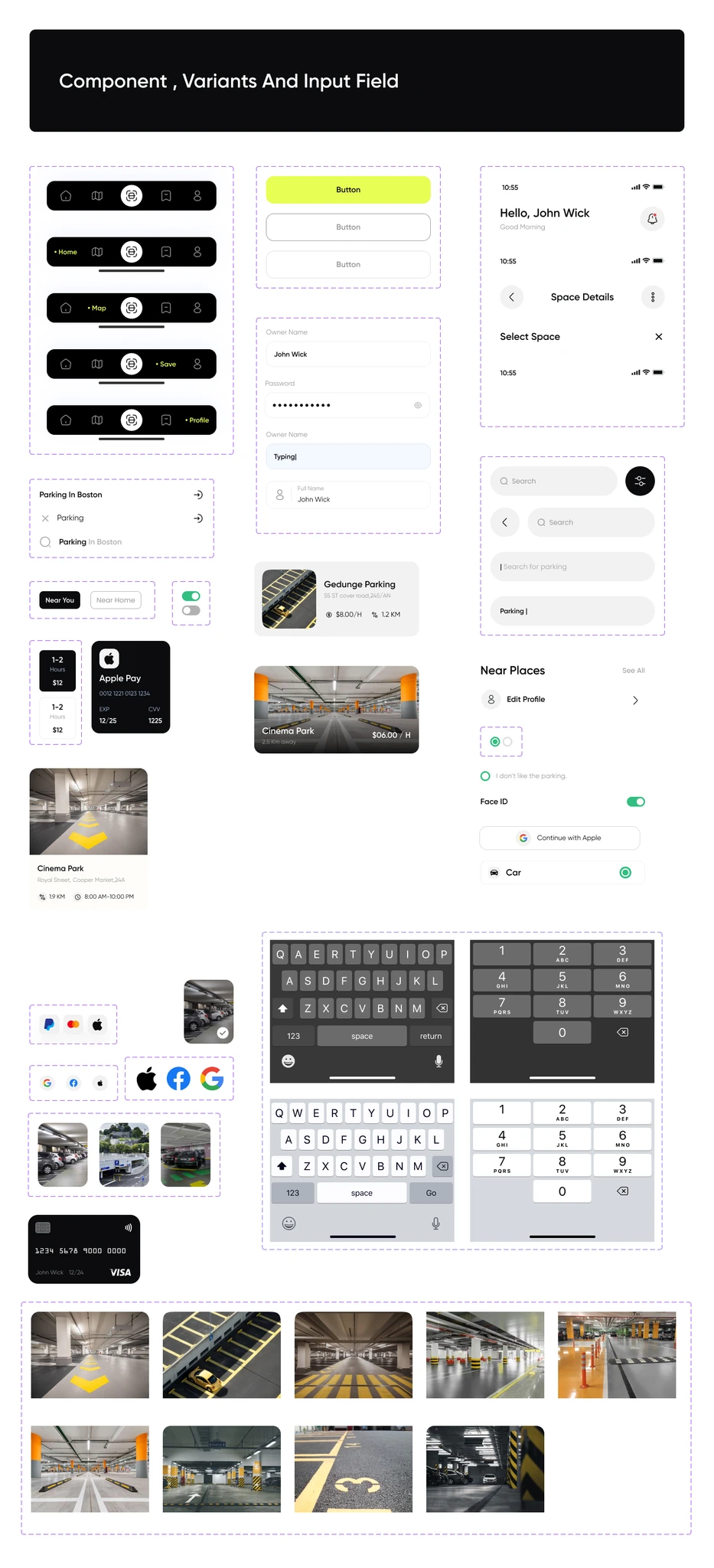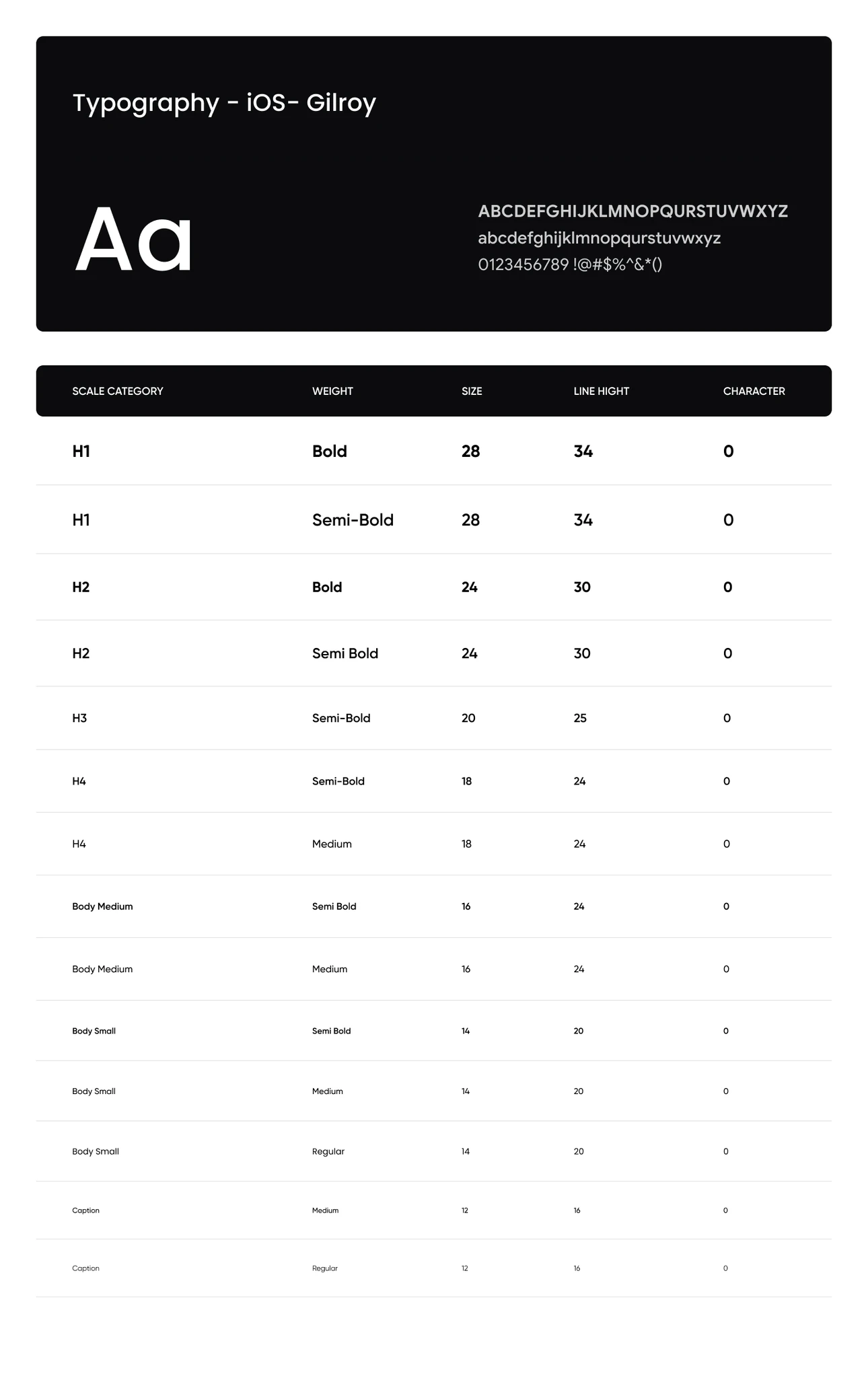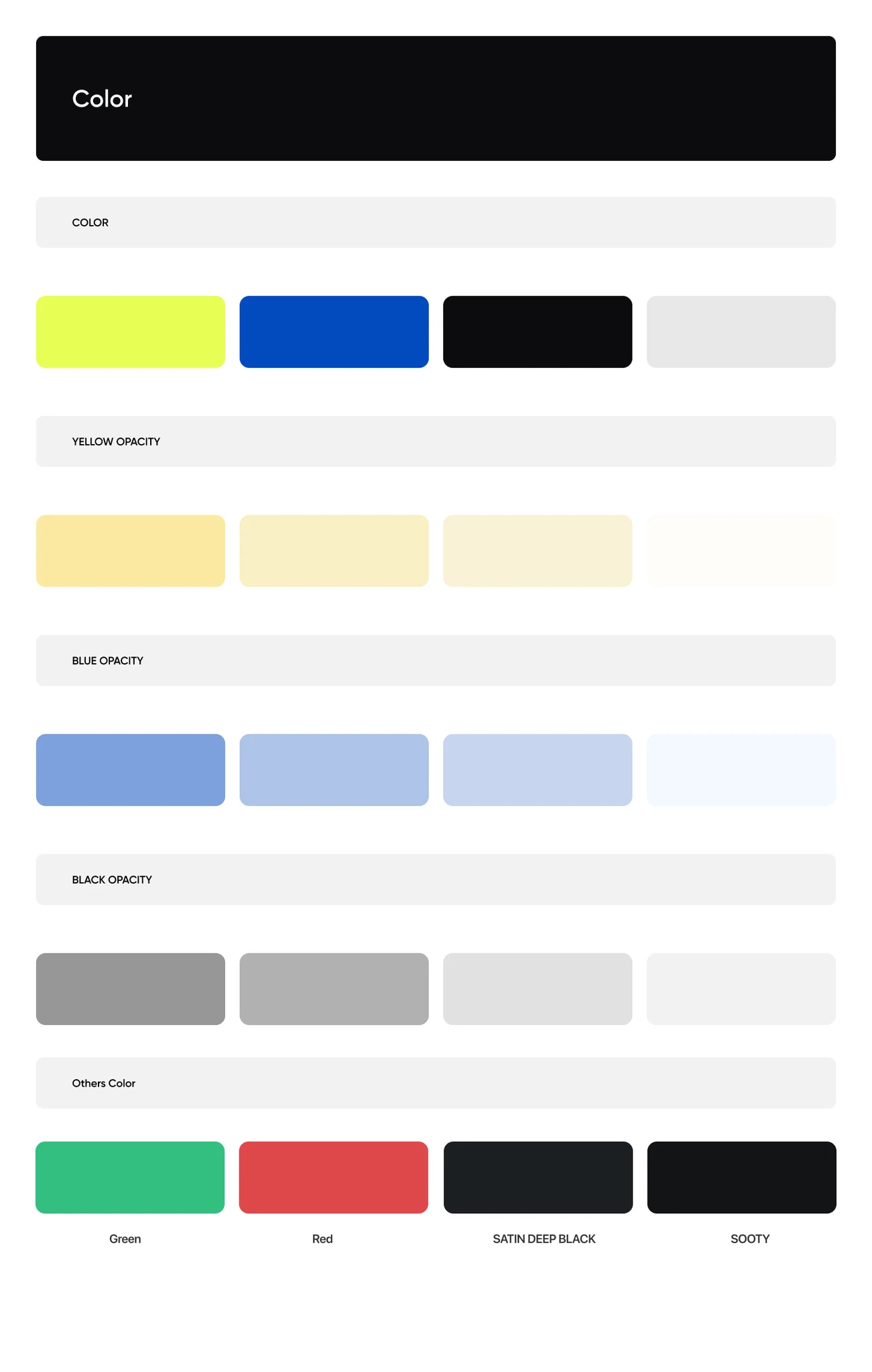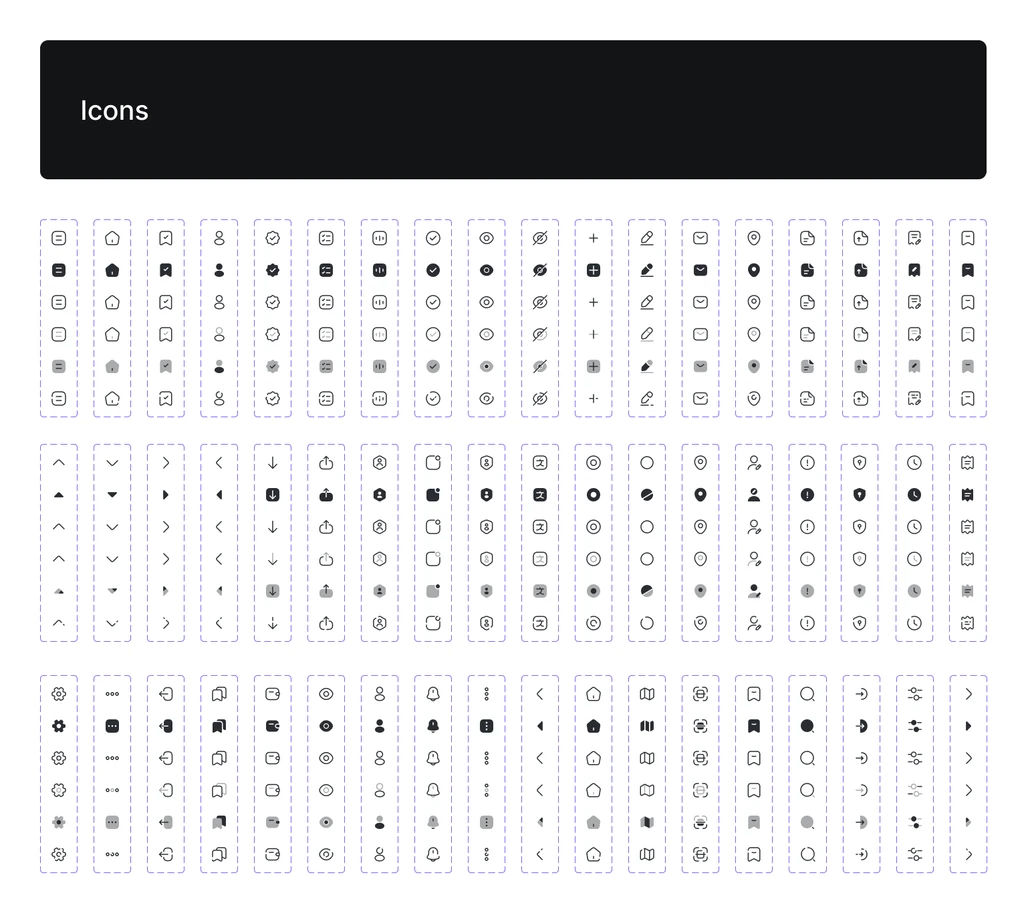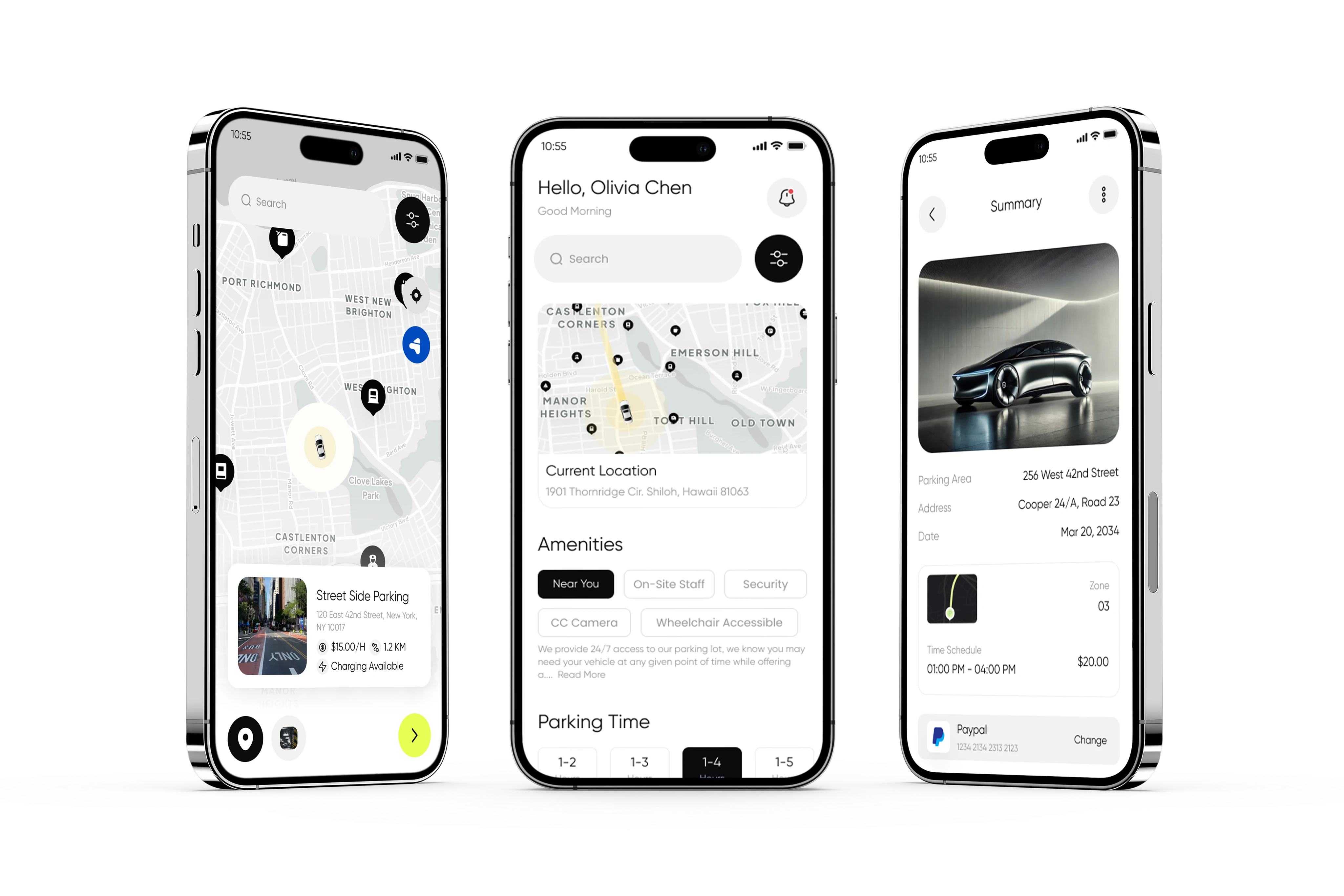SmartPark AI
which enhances urban mobility by solving parking challenges with advanced technologies.
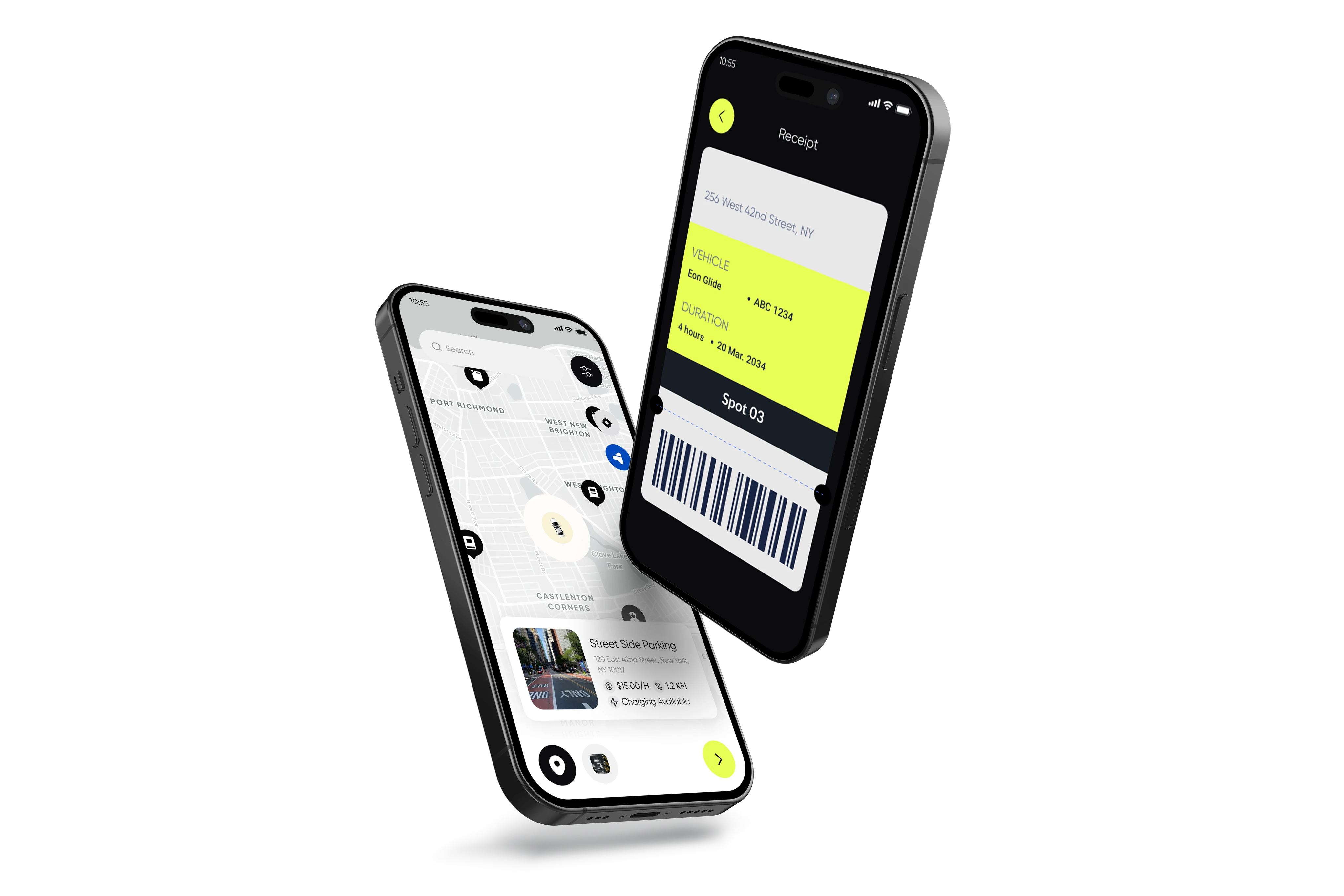
Overview
Background
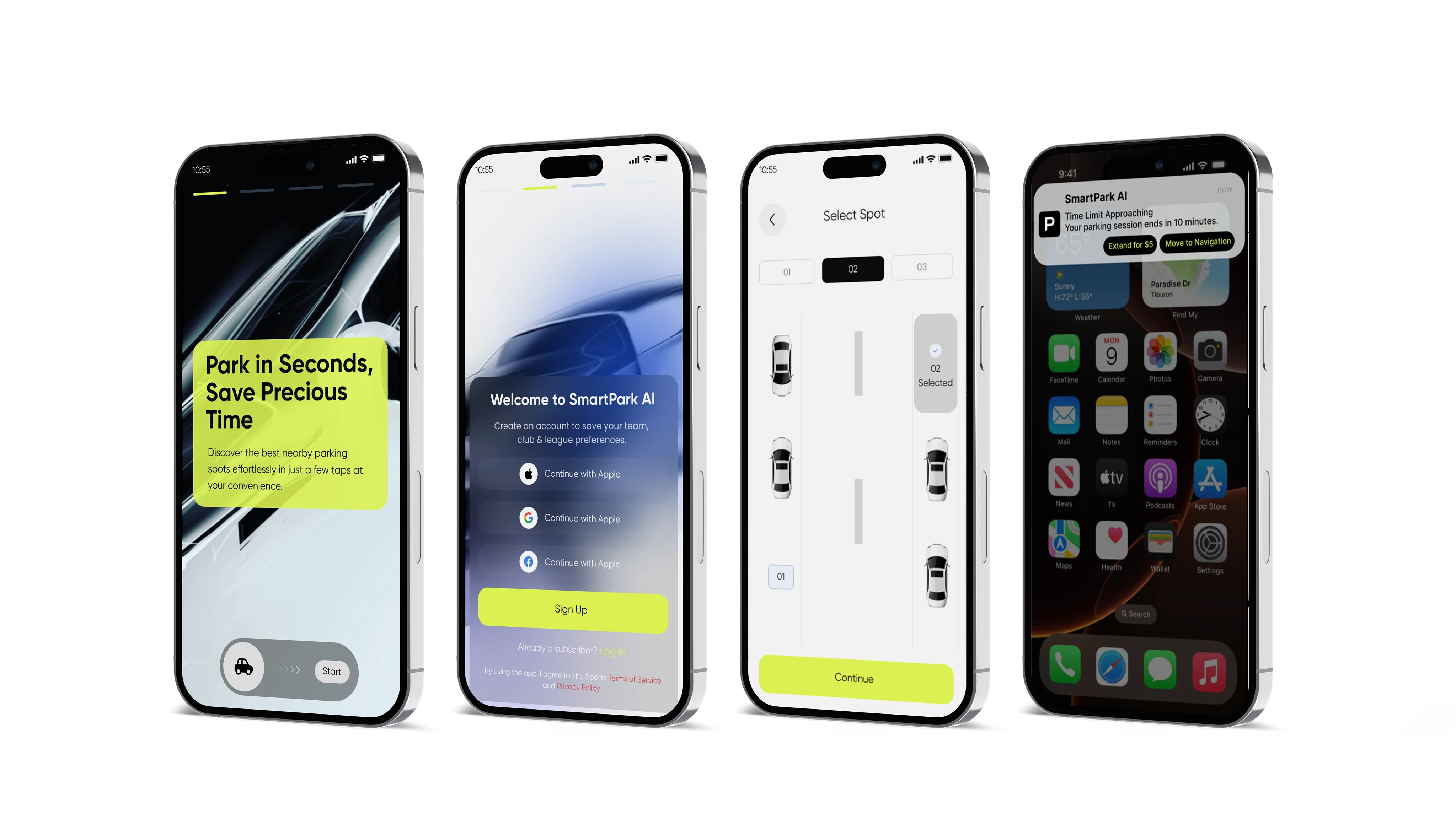
Parking remains one of the most persistent challenges in urban transportation. While current technologies, such as Tesla’s autopilot and smart parking features, have made significant progress, they still fall short of solving the problem entirely. SmartPark Vision takes a bold leap forward, imagining a future where parking is seamless, autonomous, and integrated into the fabric of smart cities.
Future Vision
SmartPark AI aspires to
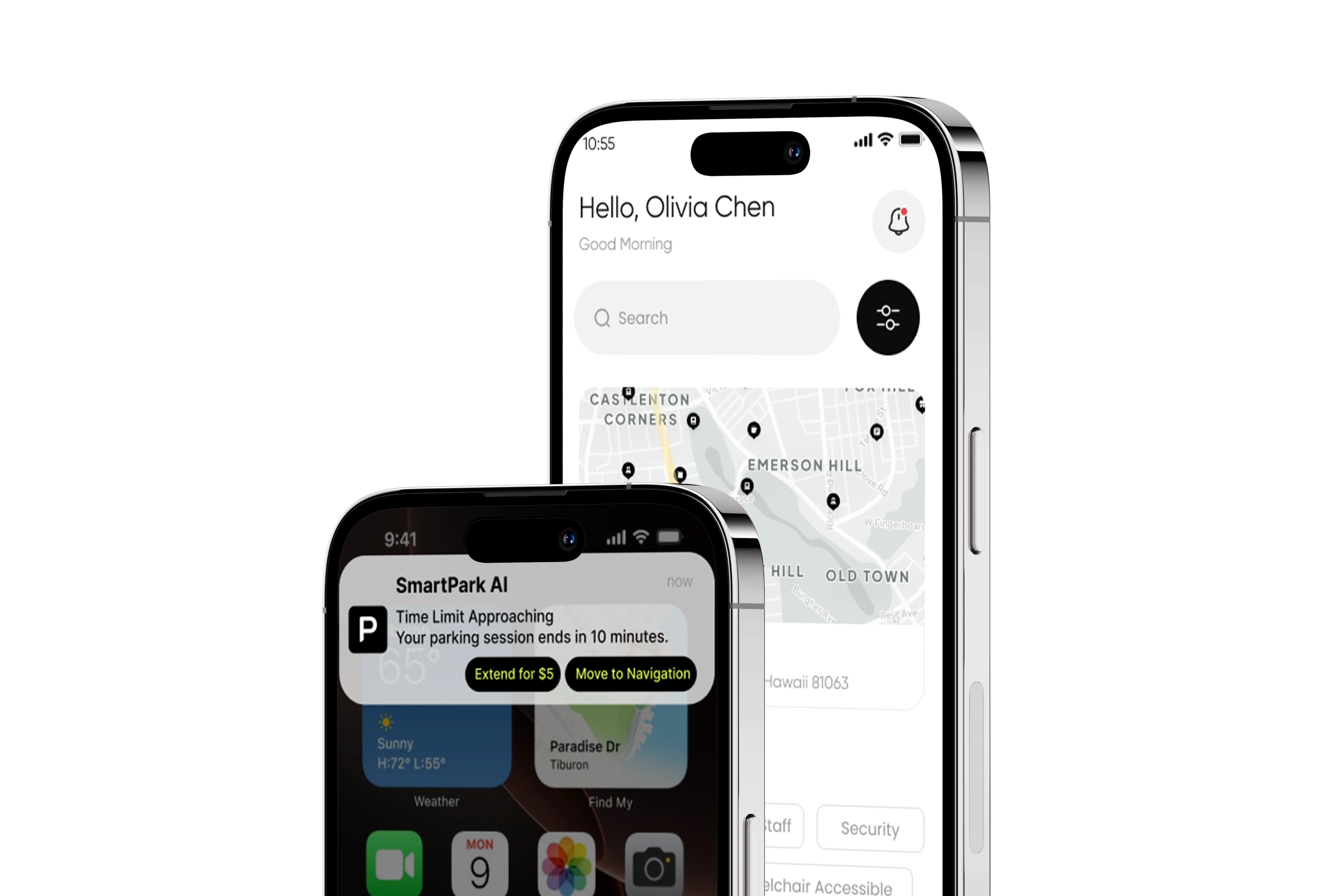
Vehicle-to-Vehicle (V2V) Parking Networks: Cars form a real-time dynamic network to share parking availability, optimizing city-wide efficiency.
City-Level Intelligent Parking Ecosystem: Smart sensors integrated into parking spaces provide instant, detailed information directly to vehicles.
Fully Autonomous Parking: Level 5 autonomy enables cars to find and park themselves without user input, while high-density lots utilize self-rearranging vehicles to maximize space.
The decision to prioritize HUD and mobile app interactions eliminates distractions and aligns with the futuristic nature of fully autonomous systems.
A Bold Step Towards the Future
Problem Statement
How might we create a seamless parking experience by integrating real-time availability, size-matching, and automated payments directly into a driver’s view?
Finding parking in urban areas is time-consuming and stressful, with challenges such as:
Limited visibility into real-time parking availability.
Street parking restrictions based on time and vehicle size.
Inconvenient payment processes, requiring apps or physical meters.
Insufficient solutions for seamless parking integration with electric vehicles and car screens.
Solution
SmartPark AI provides a future-ready, seamless parking experience using real-time data, predictive AI, and IoT integration. Users receive:
Real-time updates on street parking availability based on location, time restrictions, and vehicle size.
Automated payment processing directly through car displays.
Integration with EV charging stations for an all-in-one parking and charging solution.

Vehicle Dashboard Integration
Simplifies the task of identifying and handling parking costs through the vehicle's display, guaranteeing a stress-free trip.
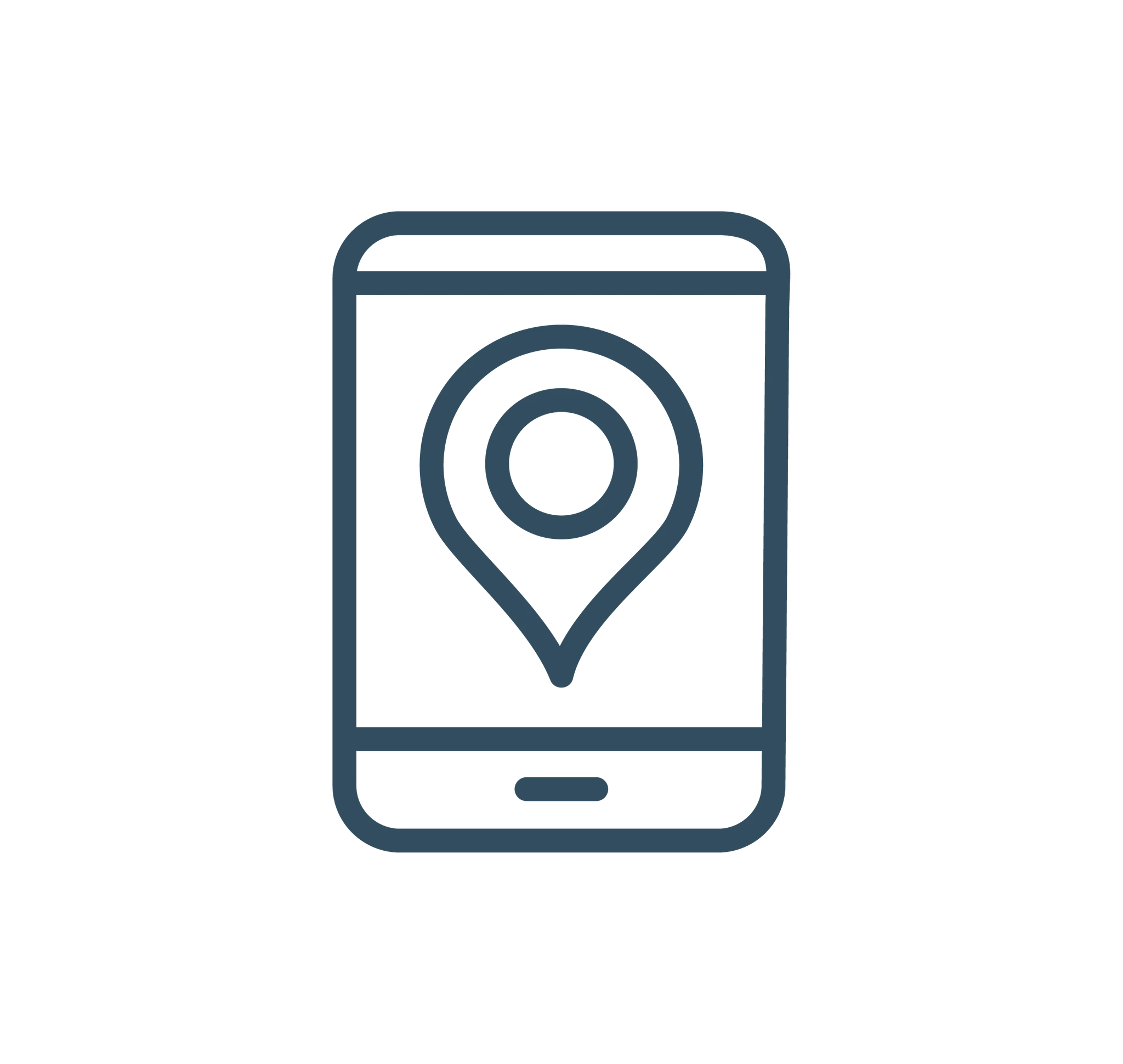
User Feedback System
Gathers feedback on parking situations, slot accessibility, and standards to enhance subsequent suggestions and precision of the system.

Personalization and Preferences
Allows patrons to personalize their parking preferences, favoring sheltered areas or electric vehicle charging sites, adapting the journey to personal requirements.

Reservation and Transaction Interface
Allows users to reserve parking spaces in advance and automates payments for stress-free transactions.

Recommends the perfect parking spots based on the car's size, parking rules, and user behavior.
Predictive AI Suggestions
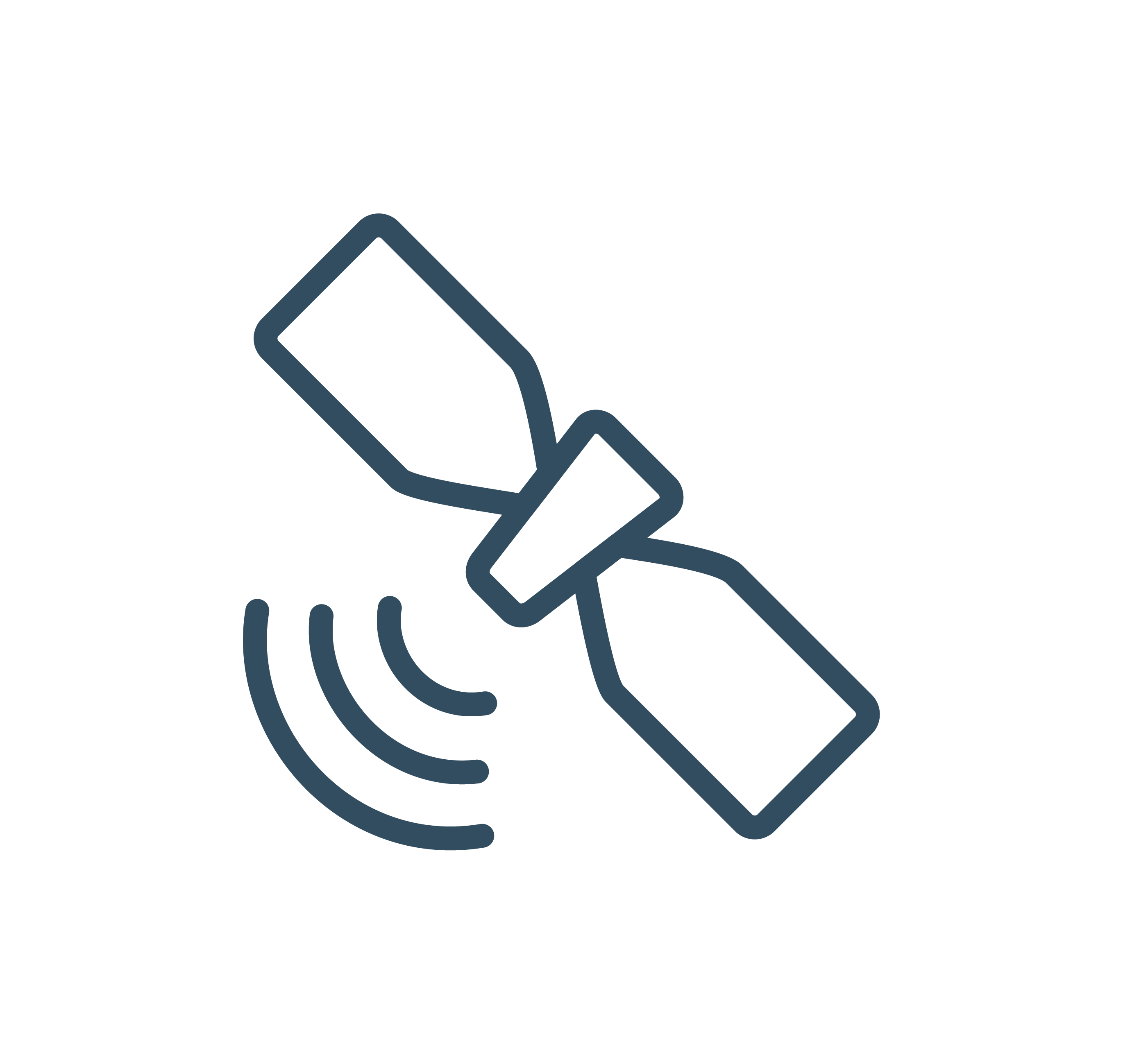
Real-time Parking Availability Updates
Shows real-time empty spots, guaranteeing motorists don’t squander time hunting.
key Feature
Competitors of Smart Park AI
Direct vs Indirect
The parking market is competitive, focusing on convenience, mobile payments, and real-time updates, but lacks in-car integration and predictive AI, leaving space for smarter, automated solutions.
Direct Competitors overview
SmartPark AI
simplifies parking with real-time spots, predictive AI, and automated payments via a HUD interface.
ParkMobile
Offers on-demand street and garage parking with mobile payments and reminders.
SpotHero
Focuses on discounted garage parking with advance booking options.
PayByPhone
Simplifies parking payments with notifications but lacks personalization.
Urban ParkMate
Provides real-time availability and reservations but with limited coverage.
Indirect Competitors overview
Citymapper
A transit app offering public transport options and real-time updates.
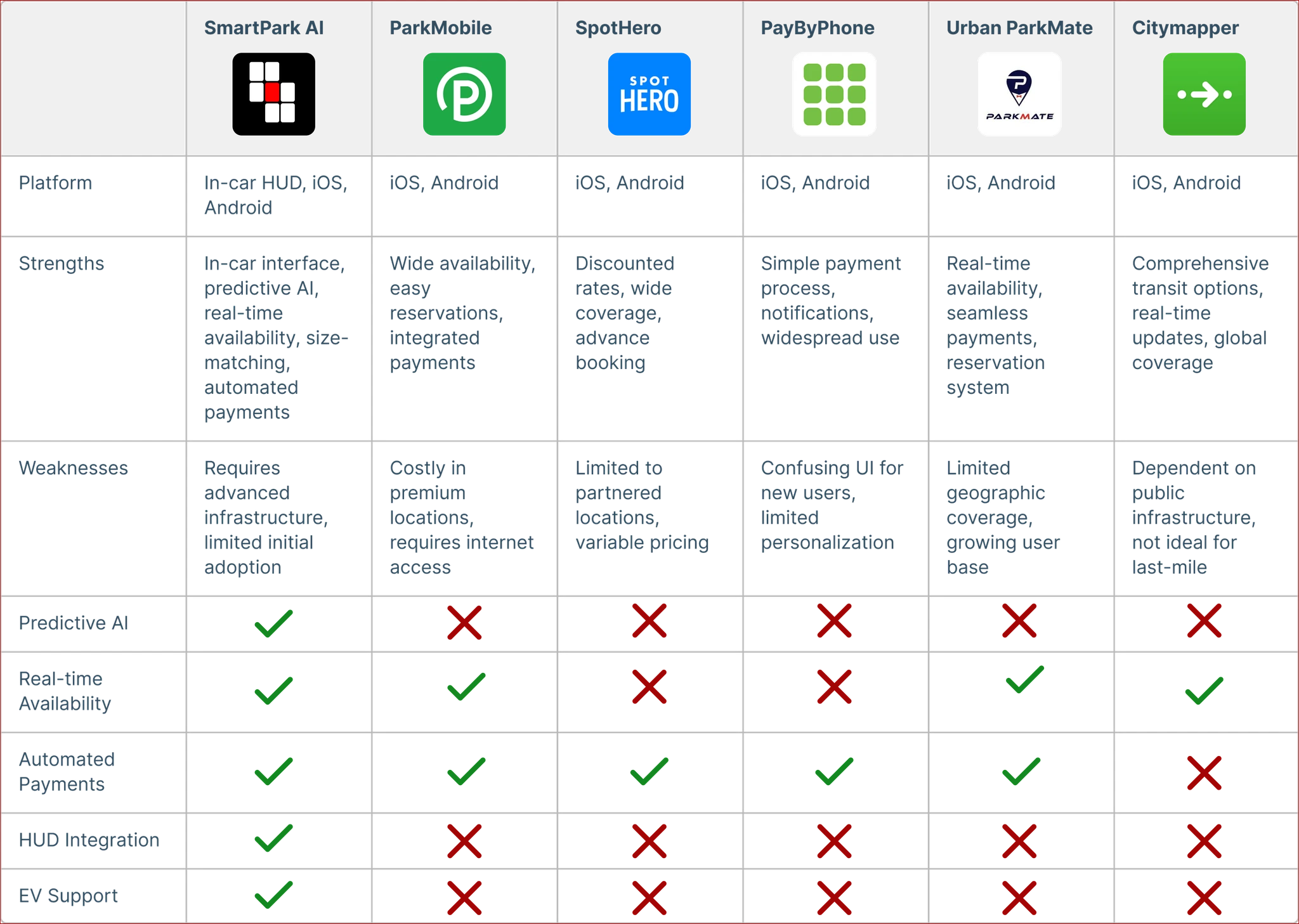
Smart Park AI's Key Advantage
SmartPark AI stands out by seamlessly integrating real-time parking availability, predictive recommendations, and automated payments directly into the driver's view, offering a safer, faster, and more personalized experience than traditional parking solutions.

Olivia Chen
Age: 34
Occupation: Marketing Manager
#DailyDriver #StreetParkingPro #TimeSaver
As a busy marketing manager working in Manhattan, Olivia relies heavily on her car for her daily commute. She often parks on busy streets and used ParkMobile for parking, but found it frustrating when she had to constantly renew her sessions or hunt for a legal spot. Olivia has even received tickets because she missed parking limits by just a few minutes. She is looking for a hassle-free parking experience that saves her time and keeps her focused on work.
⚠️ Frustrations:
Parking availability is often limited, especially during peak hours.
Renewing parking manually is disruptive and can lead to missed sessions or fines.
🏁 Goals:
Use predictive AI to find the best available spot before arriving.
Eliminate the hassle of renewing sessions with automated payments through the HUD display.
Prefer personalized suggestions for her car size and time slot.
Persona 1: Olivia Chen - The Urban Communter
Persona 2: Jason Miller - The Occasional Driver
Jason Miller
Age: 27
Occupation: Freelance Designer
#PublicTransitFan #RideHailLover #OccasionalDriver
Jason prefers public transportation or ride-hailing apps like Lyft to get around Brooklyn, using his car only on weekends when attending events with friends or moving large items. He finds most parking apps overwhelming with too many settings and dislikes the stress of searching for parking in the city. Jason doesn’t drive often enough to use traditional parking apps regularly but needs occasional parking assistance for special outings.
⚠️ Frustrations:
Parking in unfamiliar areas is stressful, especially with complicated apps.
He prefers simple solutions to avoid wasting time on settings and manual processes.
🏁 Goals:
Receive parking recommendations only when needed, based on his driving patterns.
Use HUD-based notifications that simplify the experience when driving.
Avoid any extra complexity, focusing only on weekend convenience.

Persona
🙌
"I want a parking solution that saves me time, helps me avoid tickets, and works seamlessly without needing my constant attention."
🛑 Pain Points
Constantly searching for street parking leads to wasted time and stress.
Manual renewal of parking sessions causes distractions and risk of fines.
Parking apps like ParkMobile lack predictive suggestions, making it hard to find the perfect spot.
Time & Cost Estimation
🕗
Time Spent Parking:
~1 hour per day searching or renewing parking
💵
Monthly Parking Cost:
~$400 (including street parking fees and occasional fines)
🛑 Pain Points
Rarely drives, so most parking apps feel overwhelming and unnecessary.
Hates searching for parking in crowded areas or unfamiliar neighborhoods.
Prefers quick and simple solutions without complicated app interfaces.
"I only drive occasionally, so I need a parking solution that’s quick, simple, and doesn’t make me jump through hoops when I do use it."
Time & Cost Estimation
🕗
Time Spent Parking:
~15-20 minutes per trip
💵
Monthly Parking Cost:
~$50 (based on 2-3 weekend outings with parking fees)
SAYS
DO
FEEL

Empathy Map
The Empathy Map for Olivia Chen, an urban commuter, reveals her need for fast, stress-free parking solutions, frustration with manual renewals and parking fines, and desire for predictive tools that eliminate parking hassles, allowing her to focus on her busy day.
THINK
Olivia Chen - The Urban Commuter
User Journey
Olivia Chen - The Urban Communter
Setup &
⚙️
Pre-Drive Planning
Commute
🚗
& Usage
Parking Session
💳
& Payment
Awareness
🛎️
& Consideration
Post-Use
📊
& Retention
Olivia learns about SmartPark AI from a colleague and an ad highlighting stress-free parking and automated payments.
🛠️ Action
🥸 Feeling
⚠️ Pain Point
⏱️ Time
🗺️
Olivia downloads the app, connects it to her car’s HUD system, and checks predicted parking availability for the next morning near her office.
During her commute, SmartPark AI suggests an available spot nearby. Olivia follows the navigation and parks effortlessly.
The app automatically starts the session, shows parking rules, and notifies Olivia if time is running out. Payment is automated upon exit.
Olivia reviews her session summary after parking and reflects on the time and stress saved. She recommends SmartPark AI to her coworkers.
Intrigued but skeptical
if it will truly save her time and prevent fines.
Optimistic
about avoiding her usual parking frustrations.
Relieved
that she didn’t need to waste time circling the block.
Calm and confident
that she won’t get a fine.
Satisfied
and committed to using the app for her daily commute.

🤔
😊
😌
🧘
😁
Has tried other parking apps that failed to provide real-time street parking options.
Struggles to trust new apps after being disappointed in the past.
Dislikes complicated setups and prefers apps that work right away.
Feels that some features might take time to learn.
Used to waste up to 10-15 minutes every morning looking for parking.
Often arrived late to meetings due to parking difficulties.
Used to worry about violating time limits or forgetting to extend sessions, resulting in fines.
Needs consistent reliability to continue trusting the app long-term.
A few minutes to explore the app's features.
~10-15 minutes to install, connect, and explore.
~5-10 minutes compared to her usual parking search.
Minimal interaction required, fully automated.
~1-2 minutes to check the summary and feel reassured.
Summary of Olivia's Journey
Actions: Discover, set up, navigate, park, automate payment, and recommend the app.
Feelings: Intrigued → Optimistic → Relieved → Calm → Satisfied.
Pain Points:
Distrust of new apps due to disappointing past experiences.
Worry about violating time limits or forgetting to renew sessions.
Prefers quick setup with minimal learning curve.
Time: Minimal interaction required; saves ~5-10 minutes daily.
Impact: Olivia becomes a loyal user and advocate, sharing the app with her network and relying on it for daily commutes.
🛠️
🥸
⚠️
⏱️
💁🏻
Business Model Canvas
Value Proposition
For Businesses:
Reduces parking congestion through real-time data and predictive parking recommendations, optimizing space usage.
Maximizes space utilization by matching vehicle size with spot dimensions, increasing efficiency.
Provides data-driven insights for parking operators and municipalities to improve urban mobility and plan infrastructure.
For Users:
Hassle-free parking experience with predictive AI to guide users to available spots.
Real-time insights on parking availability, time restrictions, and fees directly via an in-car HUD interface.
Automatic payments eliminate manual transactions and minimize parking fines.
Personalized recommendations for parking based on user preferences (e.g., EV spots, covered spaces).
Key Revenue Streams
Commission from Parking Operators (40%)
Earns a fee from operators for each booking through the platform.
Subscription for Premium Features (30%)
Users pay for advanced features like spot reservations and priority access.
Partnerships with EV Stations (20%)
Revenue from collaborations with charging providers through shared commissions.
Data Analytics for City Governments (10%)
Cities pay for insights and reports to optimize urban planning.
Key Revenue Streams
Parking Operators – Provide space availability and payment integration.
City Governments – Enable data sharing and analytics services.
Automobile Manufacturers – Integrate the system into car HUDs.
EV Charging Providers – Offer combined parking and charging solutions.
Payment Gateways – Facilitate seamless transactions.
Event Venues & Retailers – Attract users with exclusive parking offers.
Futuristic Concept:
Mobile App + Car Screen + HUD System Integration
Mobile App
In-Car Infotainment Screen
Three layers of interaction
01
Before the Drive
02
During the Drive
03
Glanceable Information
Windshield HUD
Plan Routes
Users can search for destinations, check parking availability, and set preferences
Send Data to Car
Once configured, the app syncs all preferences to the in-car system.
Remote Controls
Users can pre-set climate settings or even reserve parking spots remotely.
Display Real-Time Data
Shows navigation, parking suggestions, and updates from the mobile app.
Interactive Controls
With voice control and touch options, drivers or passengers can modify routes or parking spots while driving.
Smart Suggestions
Autonomous features (like automatic parking assist) can trigger directly from this screen based on real-time data.
Simplified Indicators
Speed, navigation arrows, and alerts (like remaining distance to a parking spot).
Eye Tracking & Voice Control
The HUD responds to what the driver is looking at or a simple voice command like “Park here.”
Parking Alerts
The HUD might show available parking slots with visual markers as the driver approaches.
Wireframes
Mobile APP
Car Screen
HUD System Integration
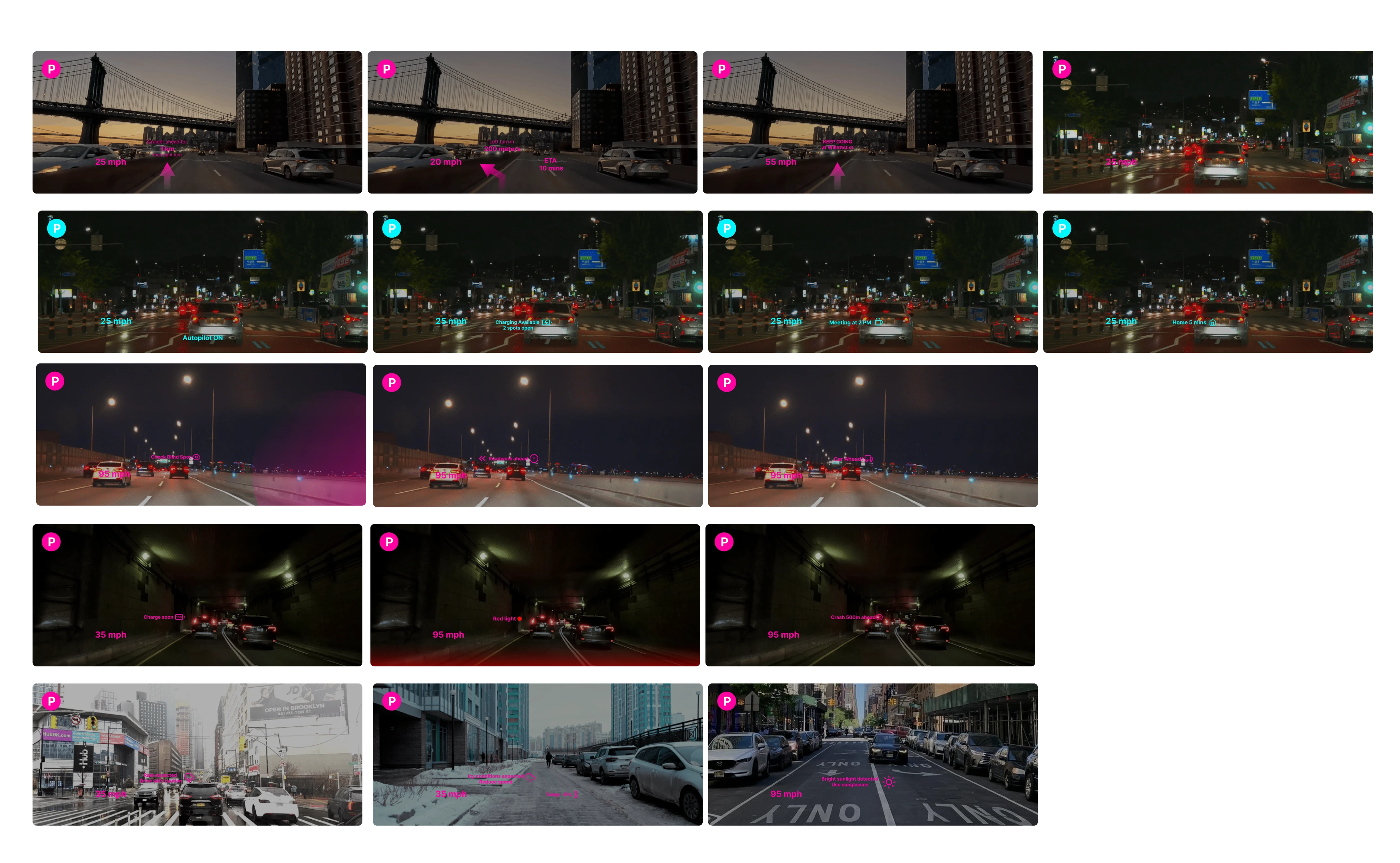
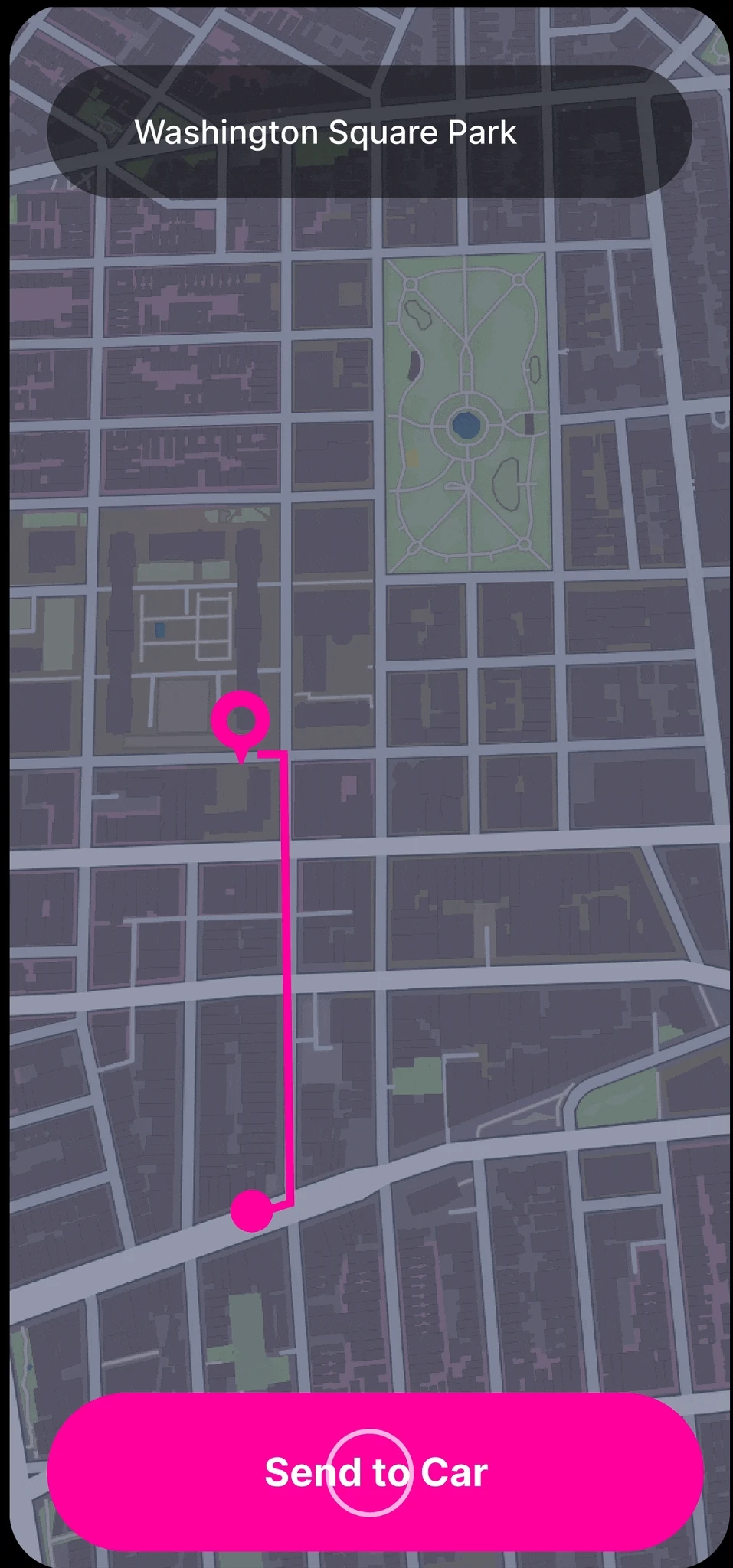
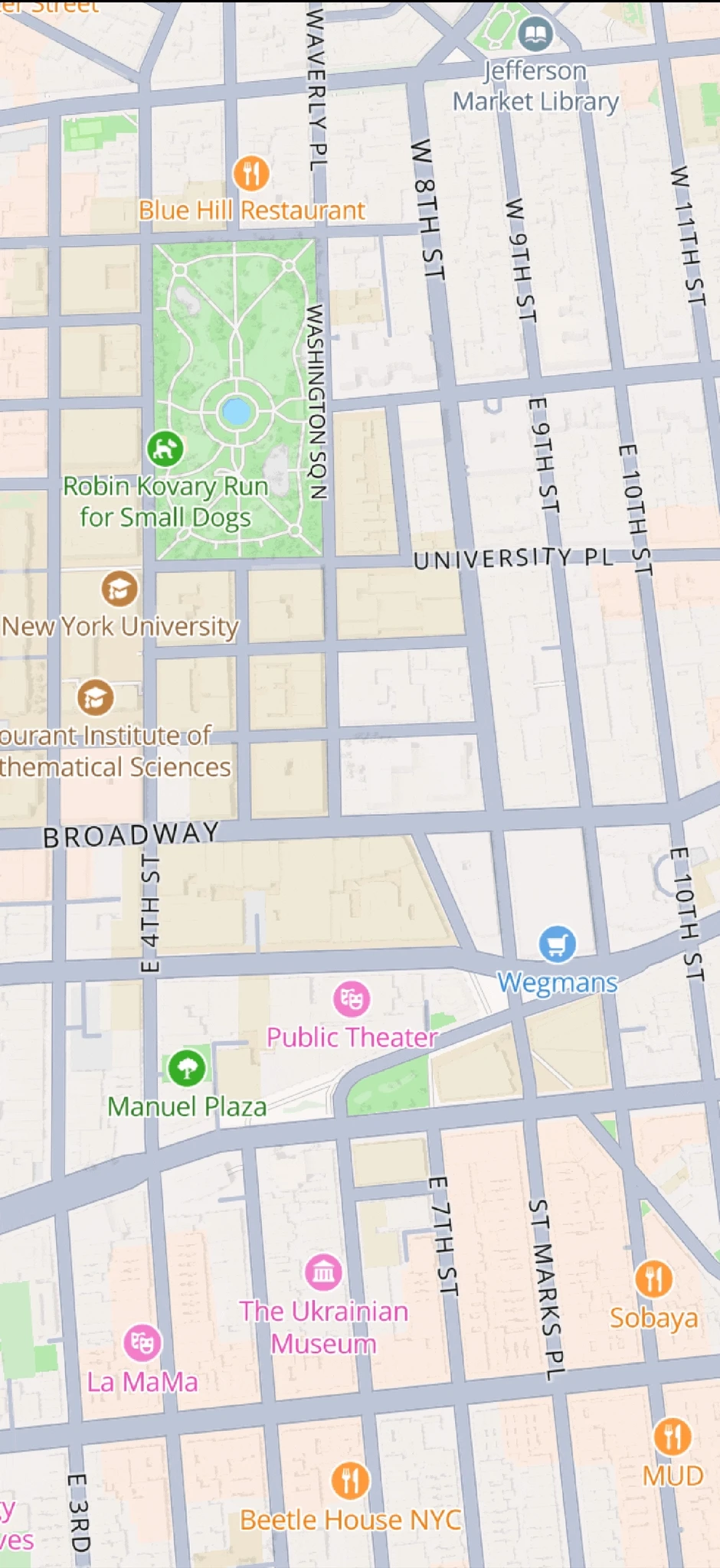
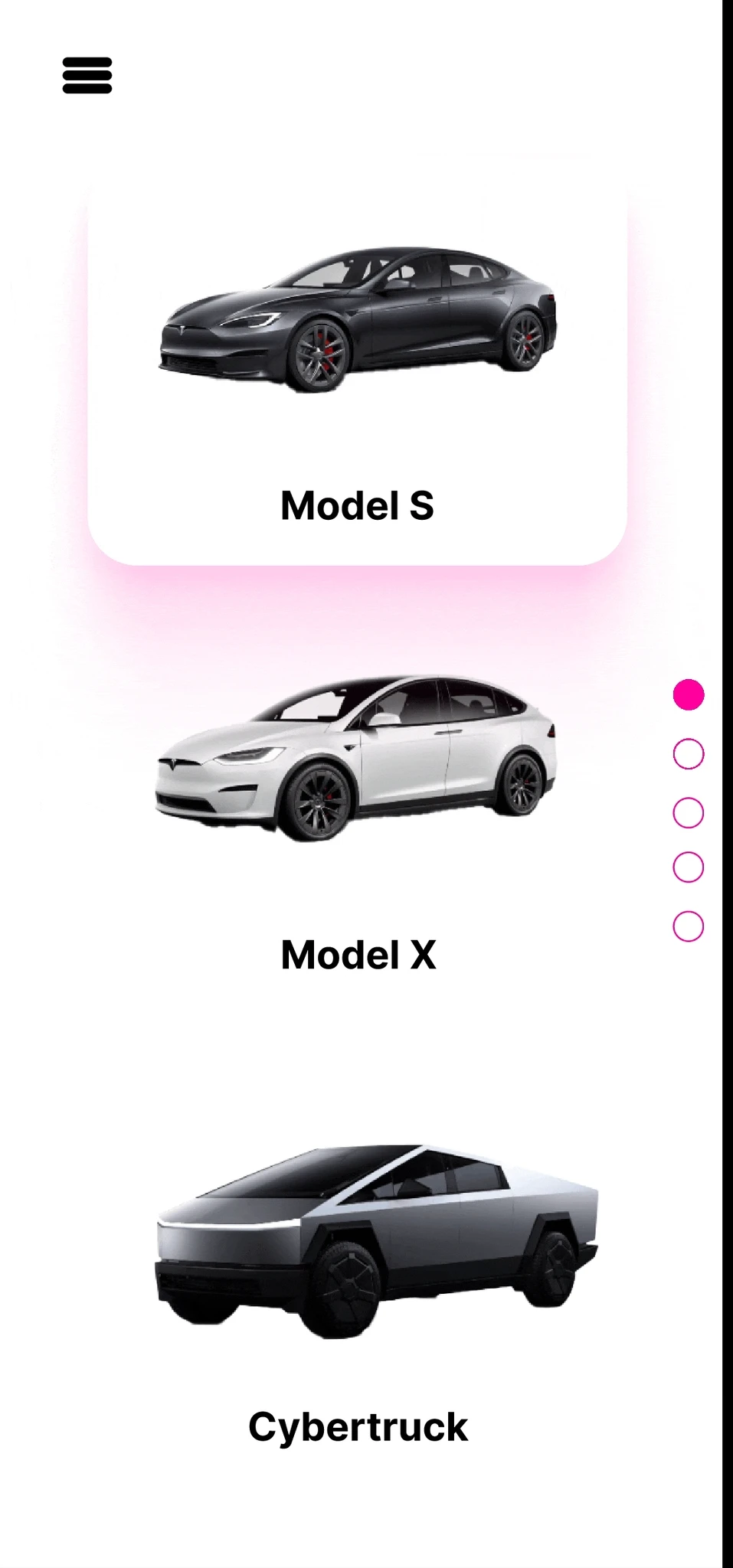
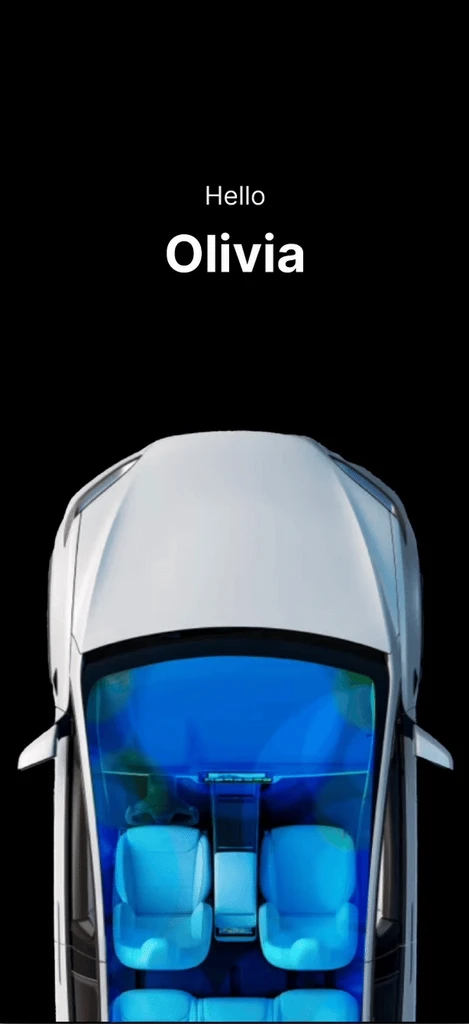

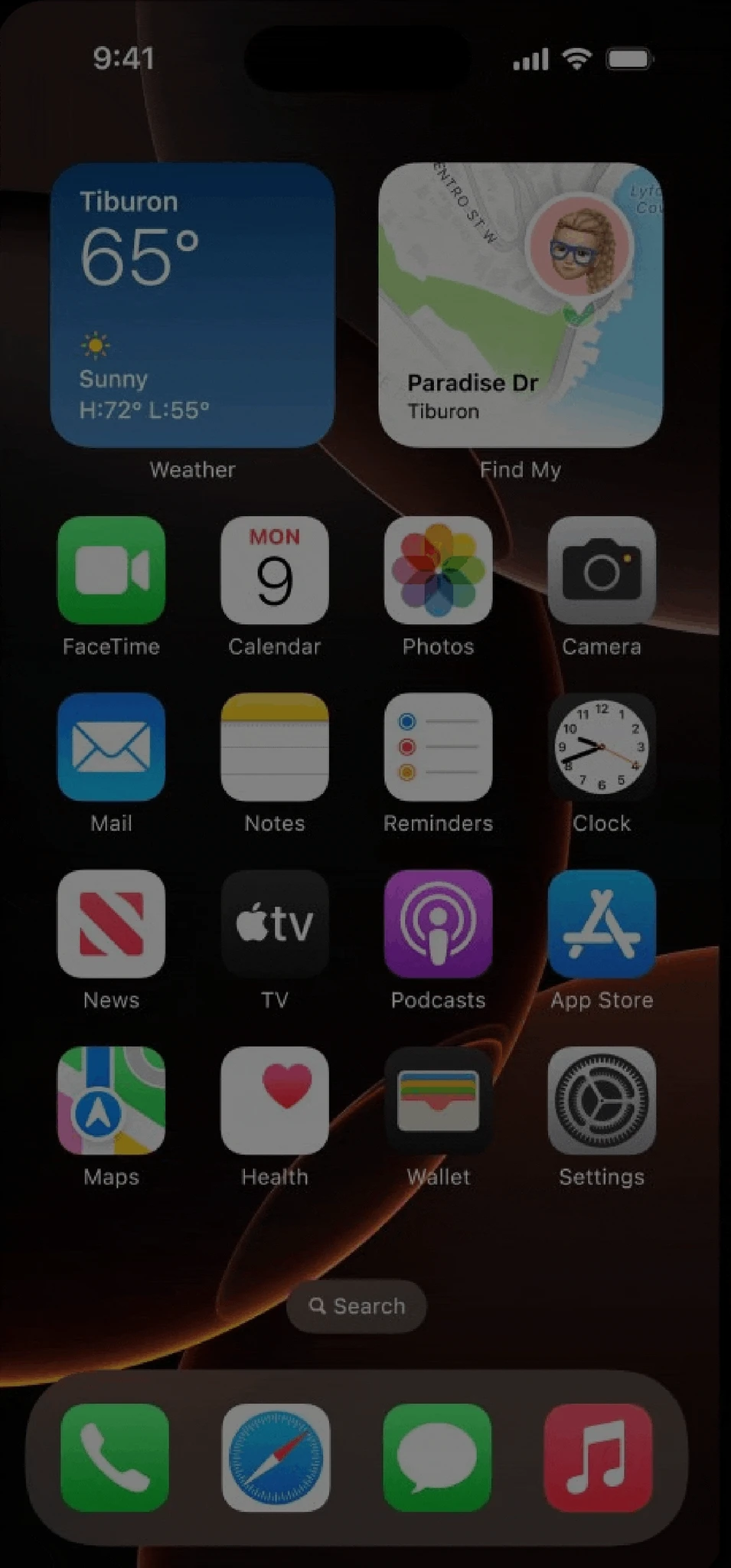
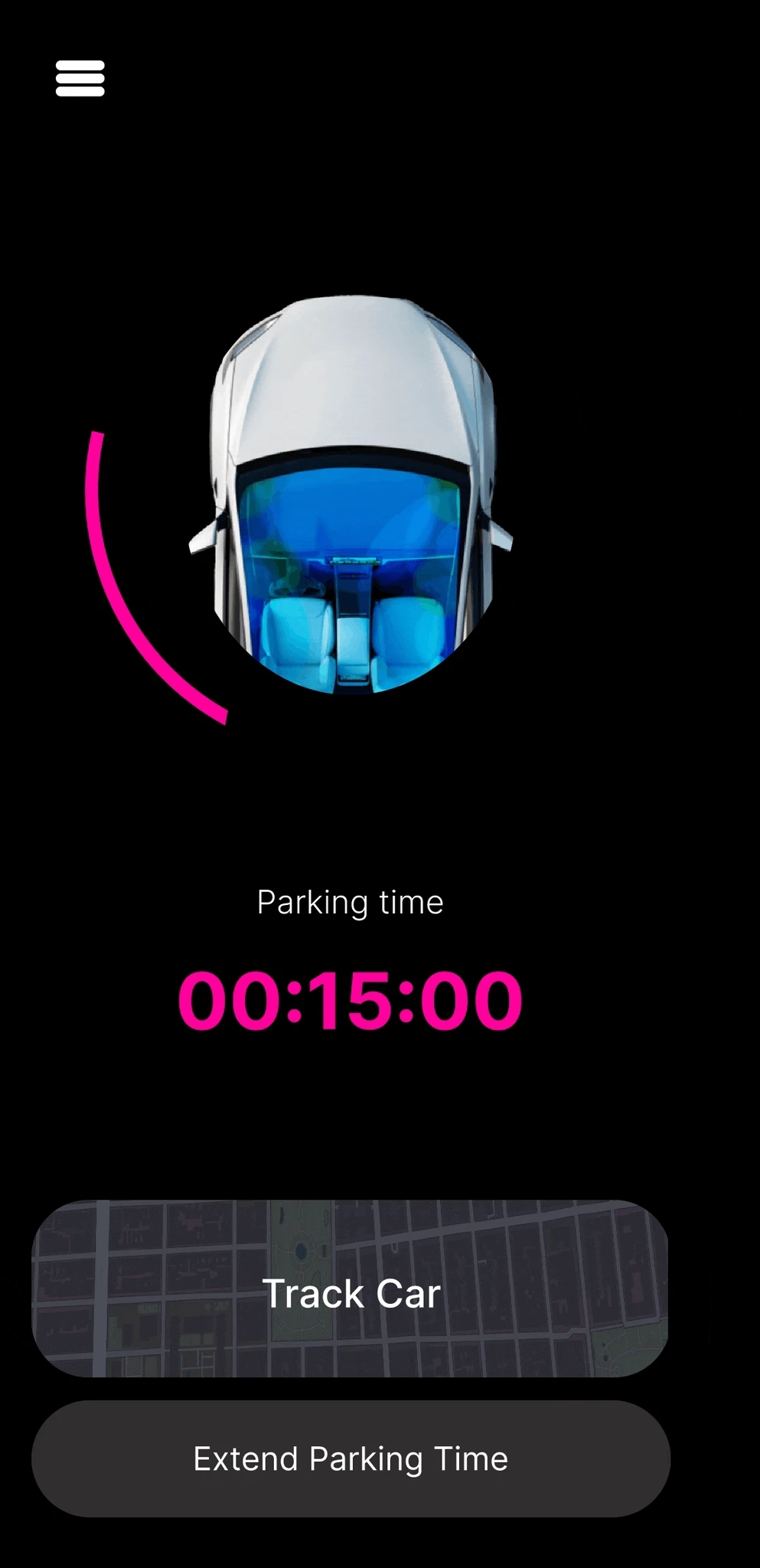

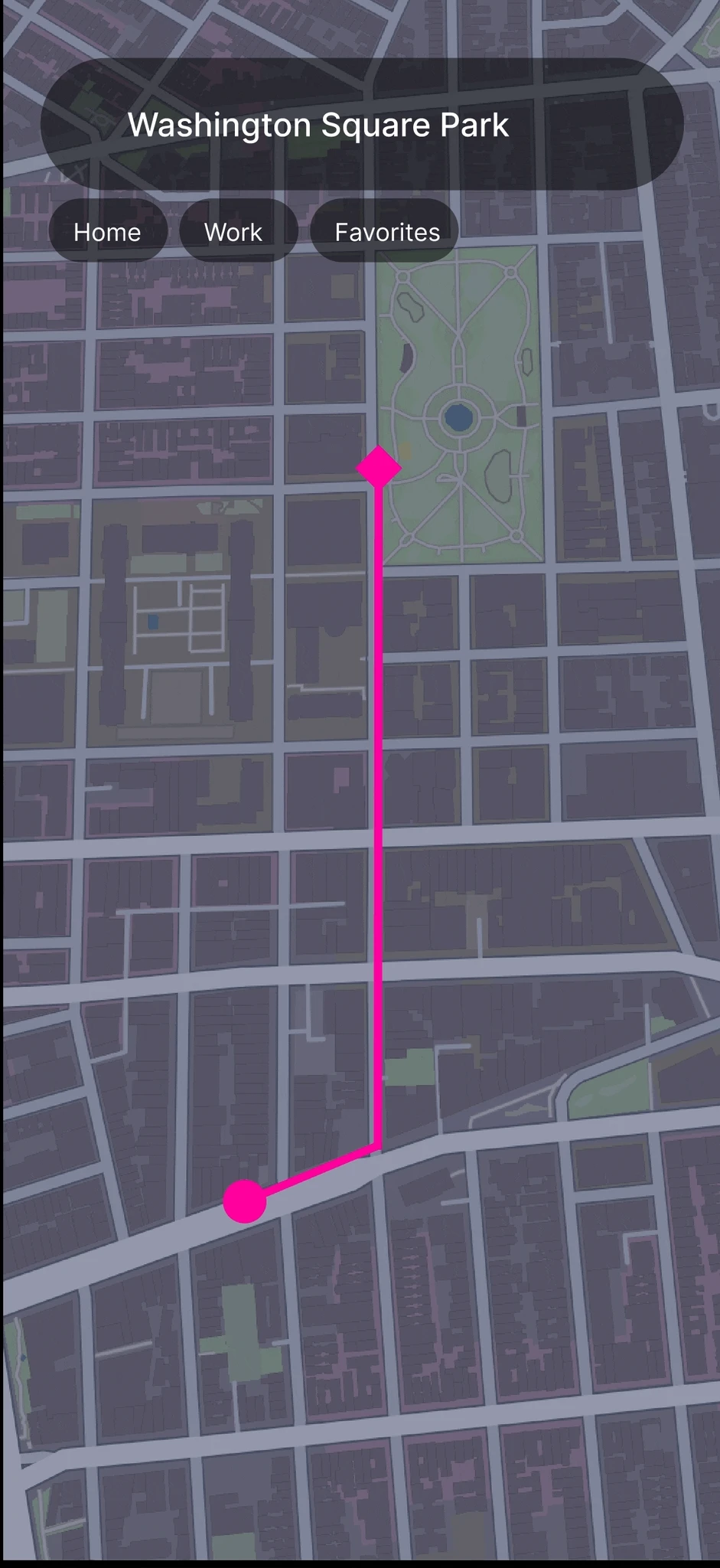

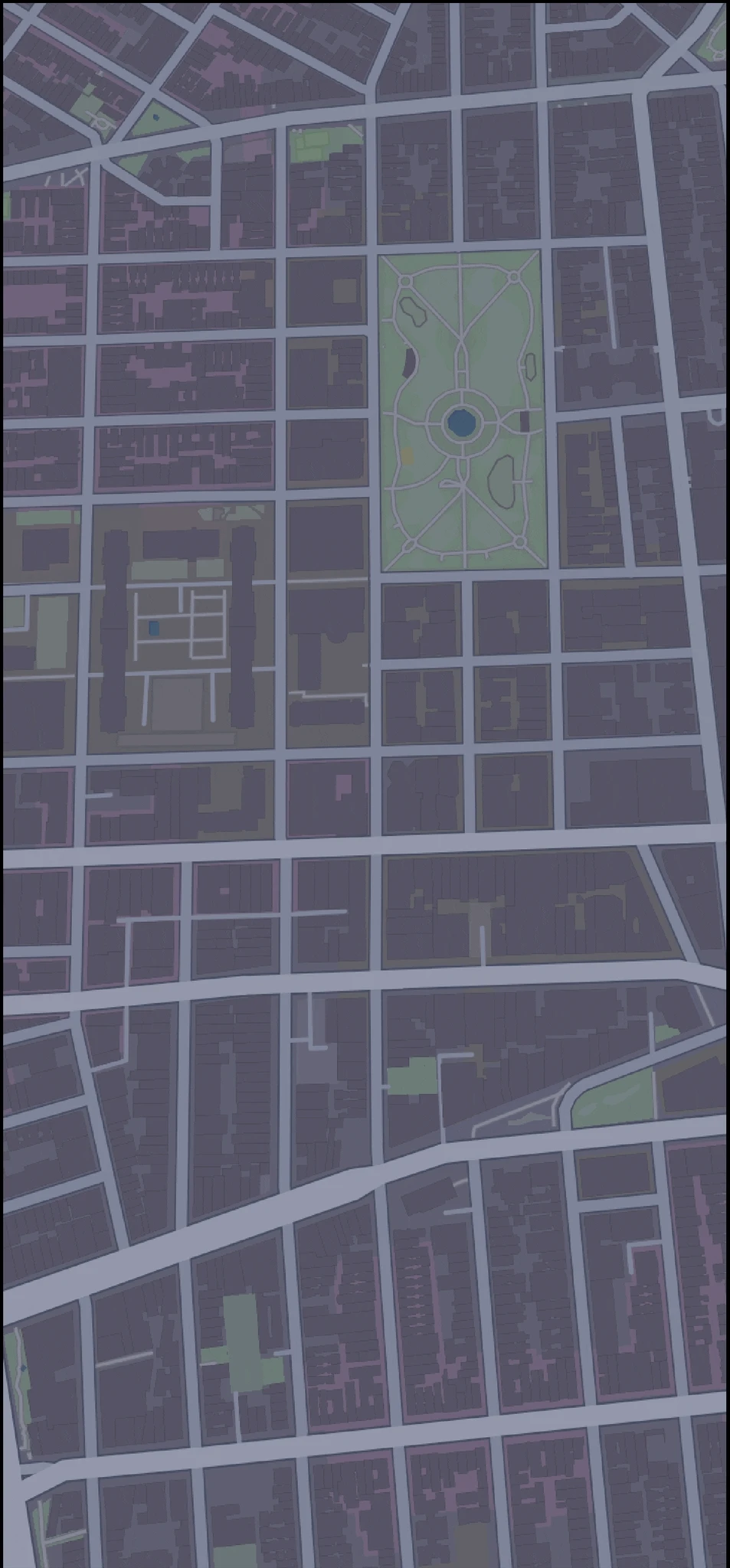
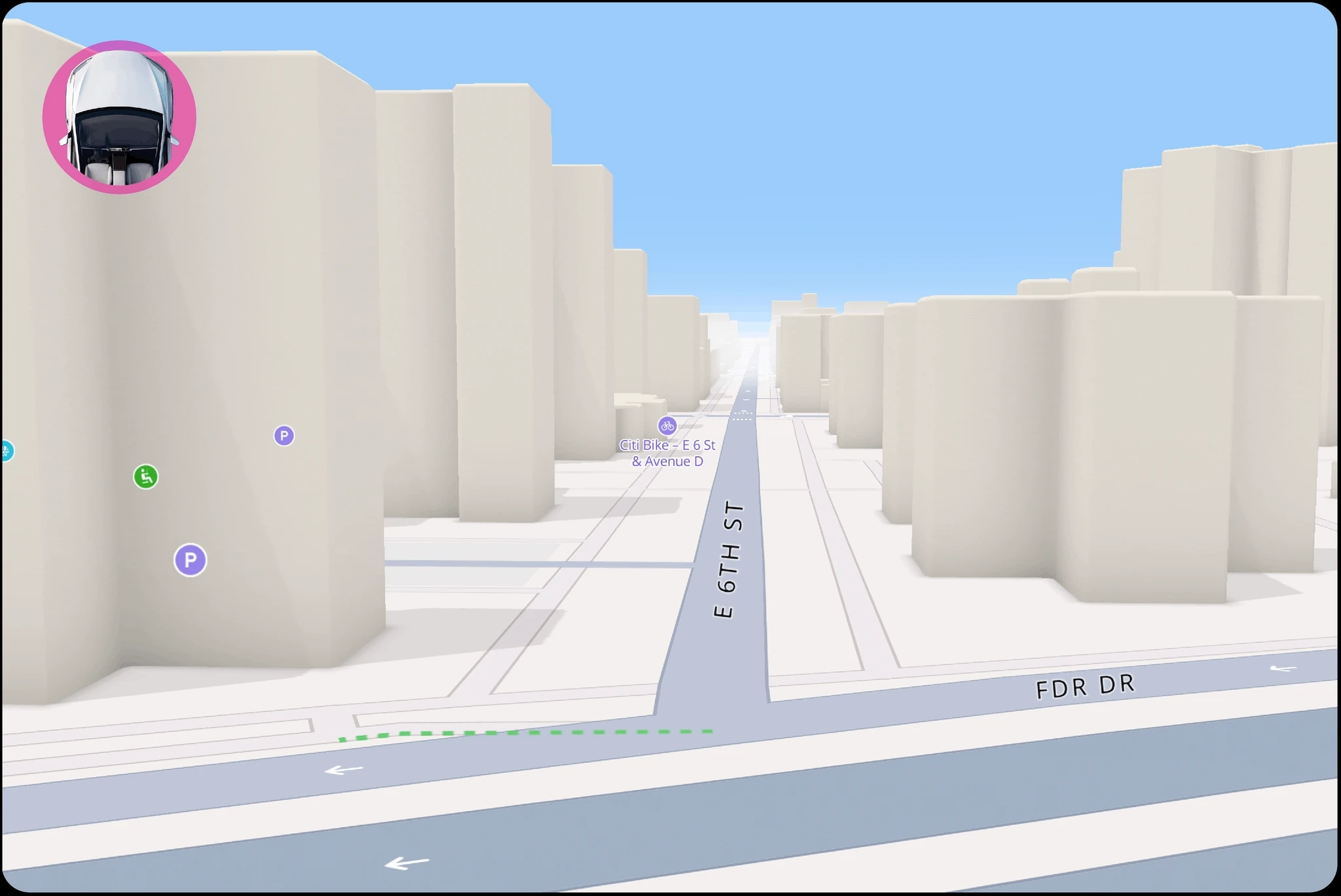
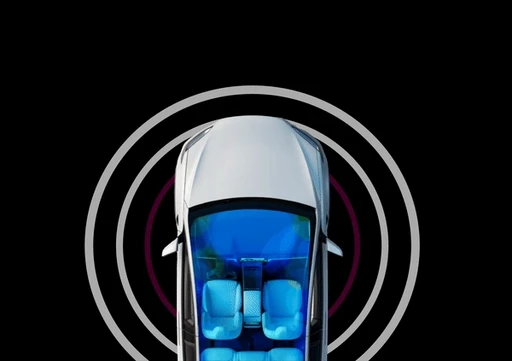
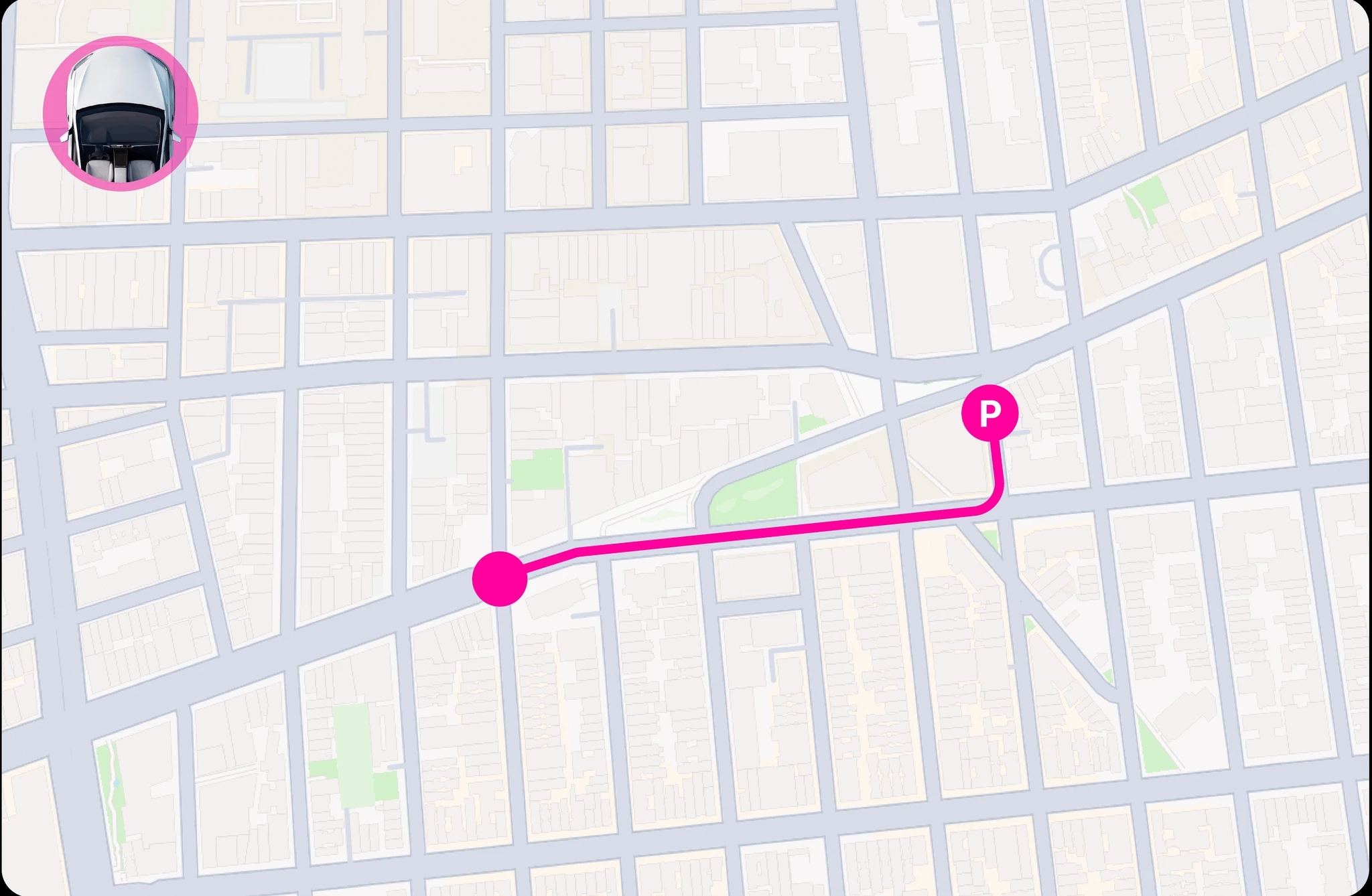
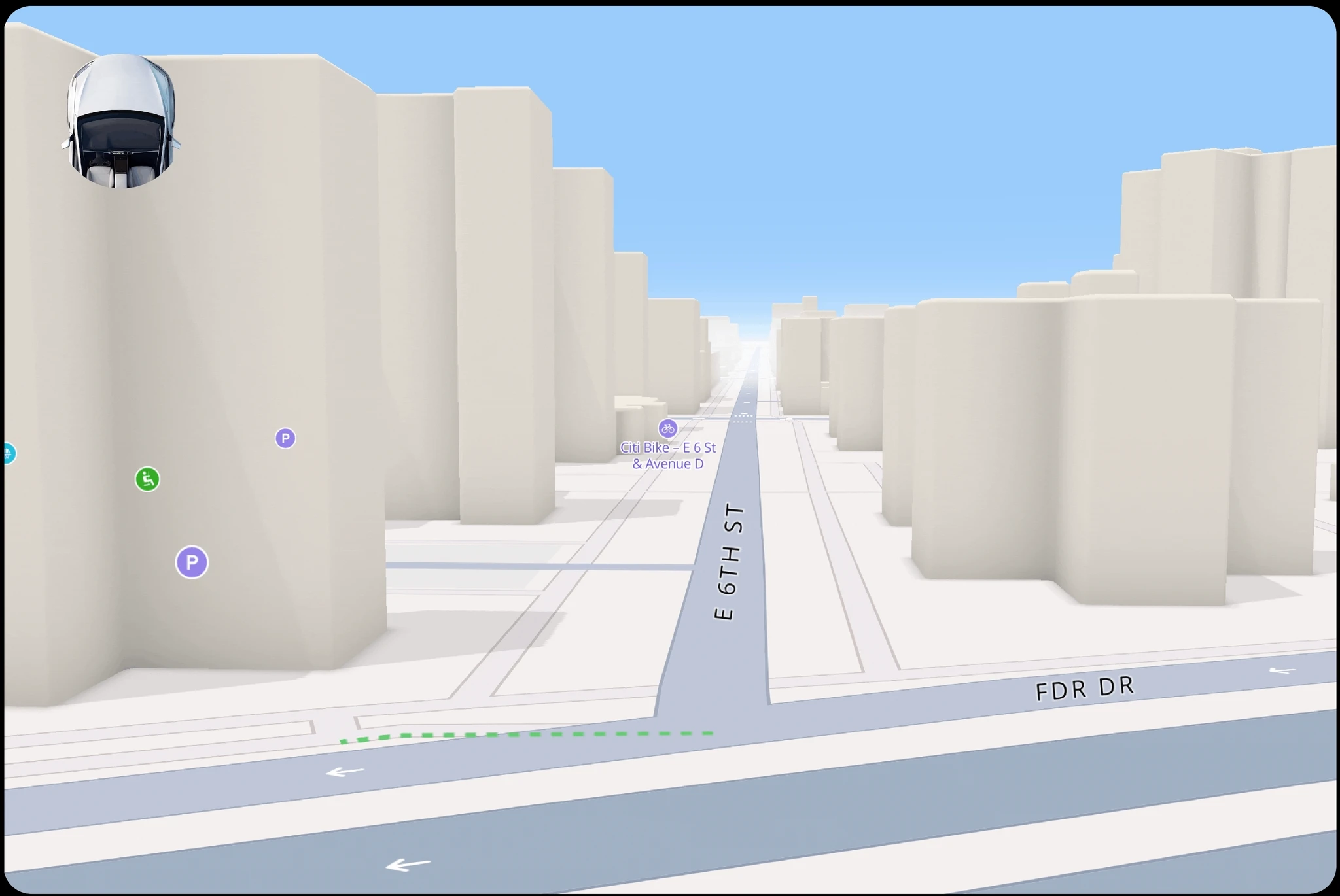
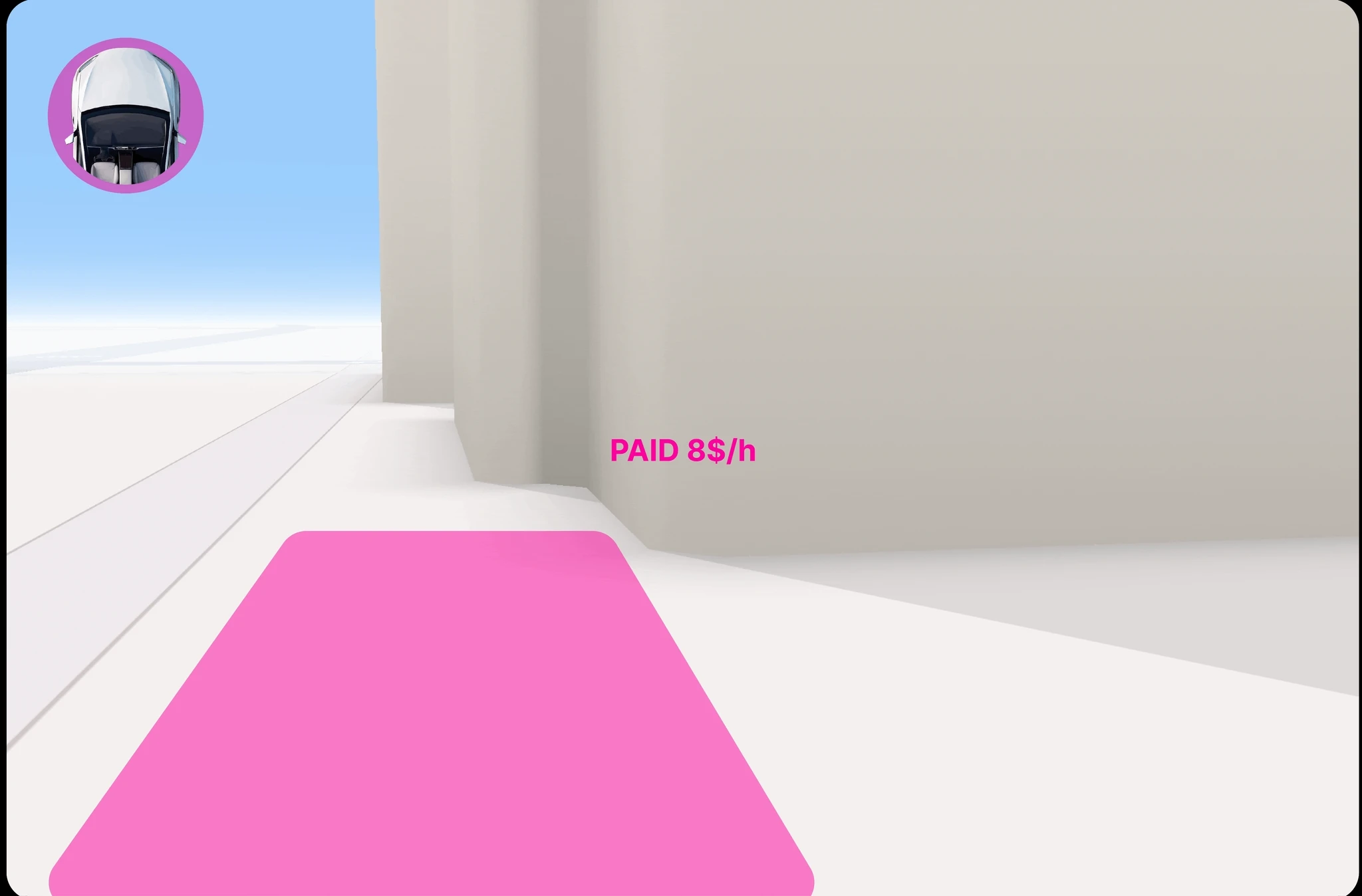
User Testing & Synthesis
Overview
We conducted user testing with 5 participants from diverse backgrounds, all of whom are frequent drivers experiencing parking challenges. The testing aimed to evaluate the usability of SmartPark AI’s core features, gather feedback on pain points, and refine the app’s integration between HUD, in-car screens, and the mobile app.
Goal
Understand user behavior and parking challenges in different environments (urban, suburban).
Validate the usability and relevance of key features: real-time parking suggestions, auto-payment, and car-size-based recommendations.
Gather actionable feedback to prioritize features and refine UI/UX design.
How It Tested
A PDF guide was prepared, outlining the testing process and key questions.
Participants joined via Zoom for remote testing.
The UI/UX prototype was shared and navigated collaboratively:
Showed key pages (HUD interface, in-car screen, mobile app).
Participants ranked pages/features as LOVE, LIKE, DON’T LIKE, or HATE.
Participants provided real-time feedback and suggestions for improvement on each screen.
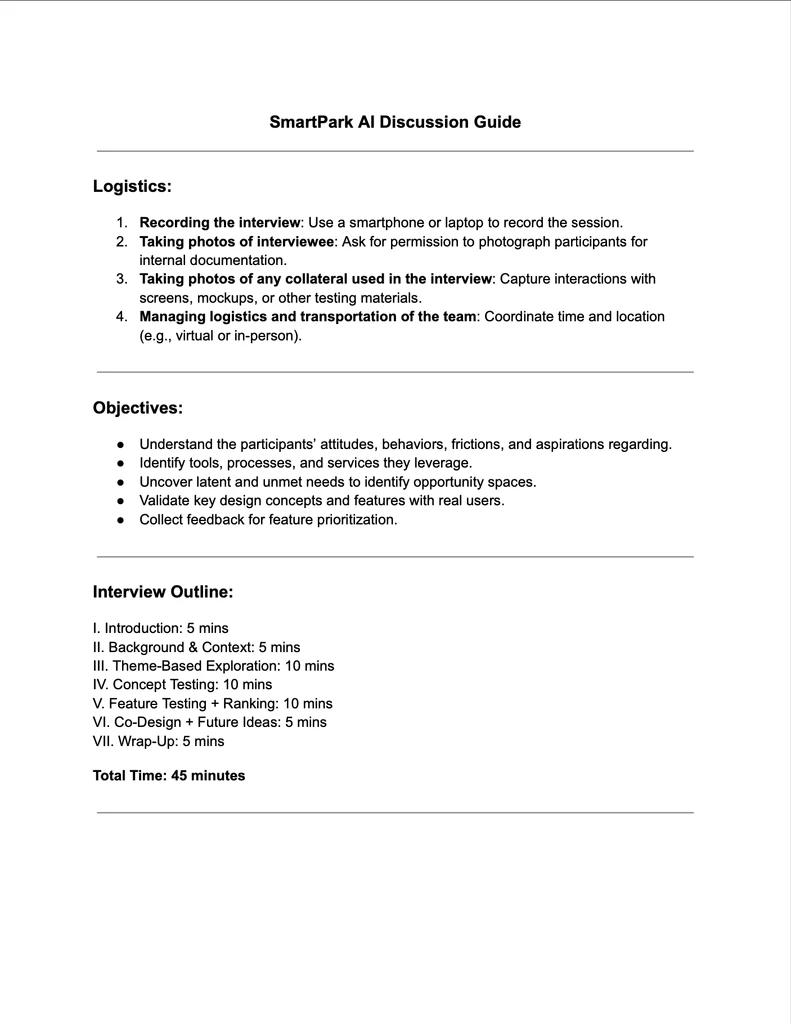
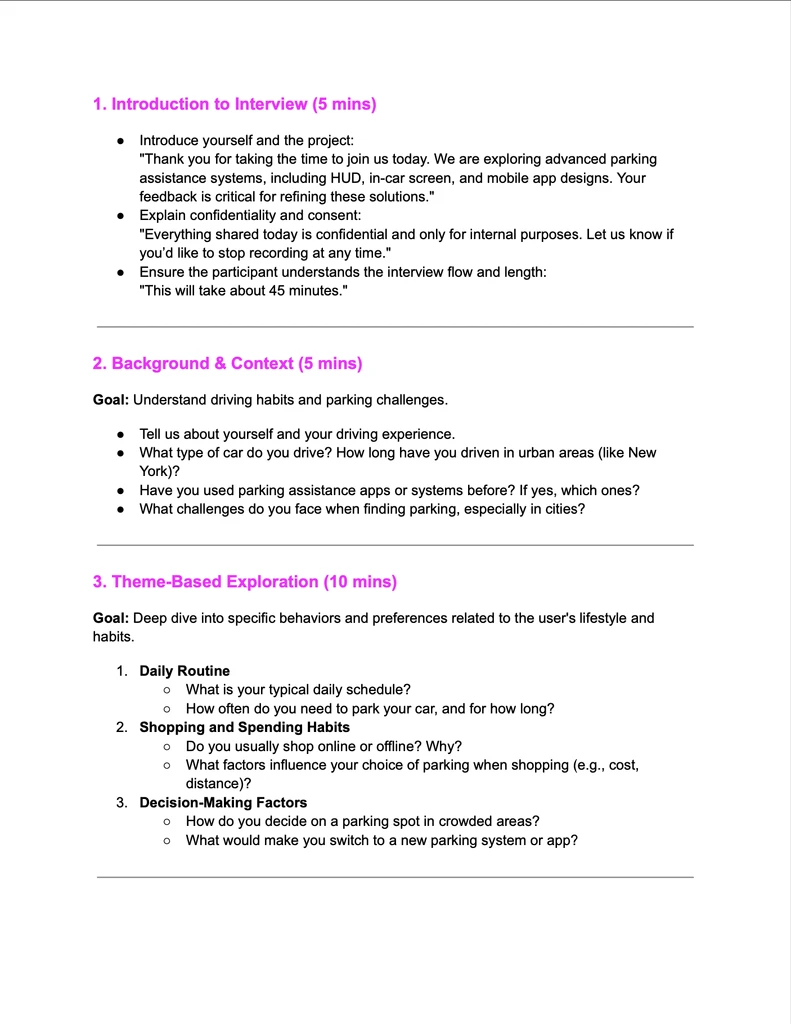
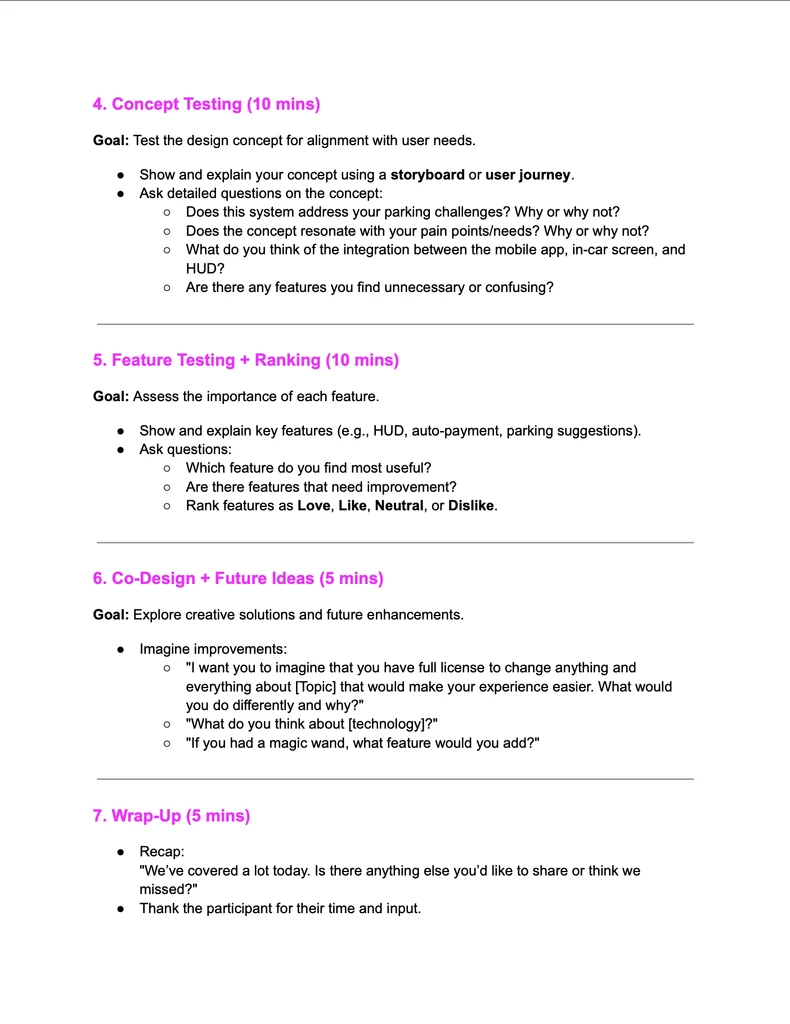
Discussion Guide
Participants
Eve
Student
New York City
Louie
Restaurant owner
New York.
Mark
Student in Irvine
California.
Lynn
Professional working
NYC


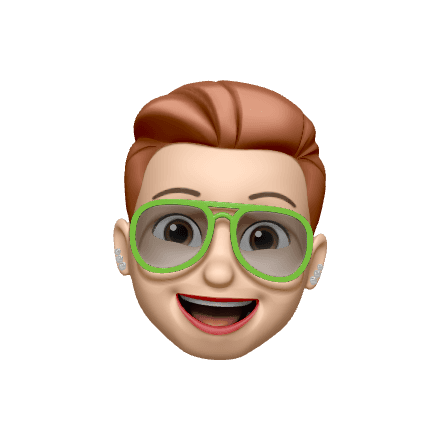


Kent
student
Pennsylvania

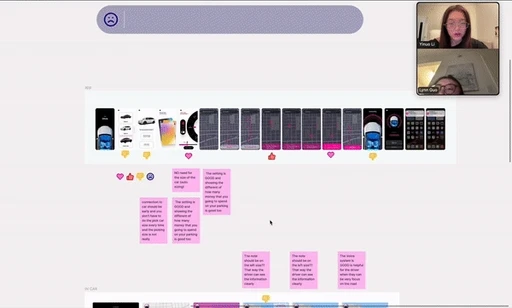
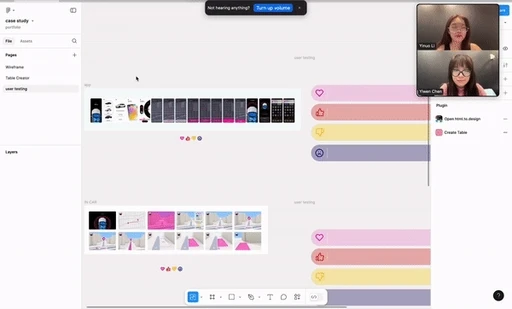
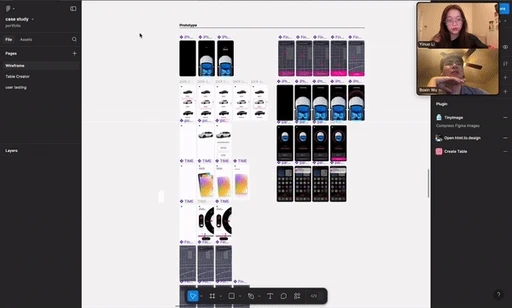
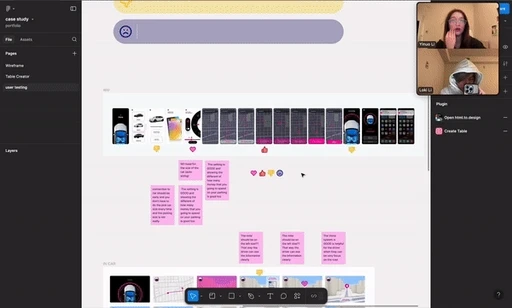
KEY Feedback & Suggestions
Feature Ranking Testing
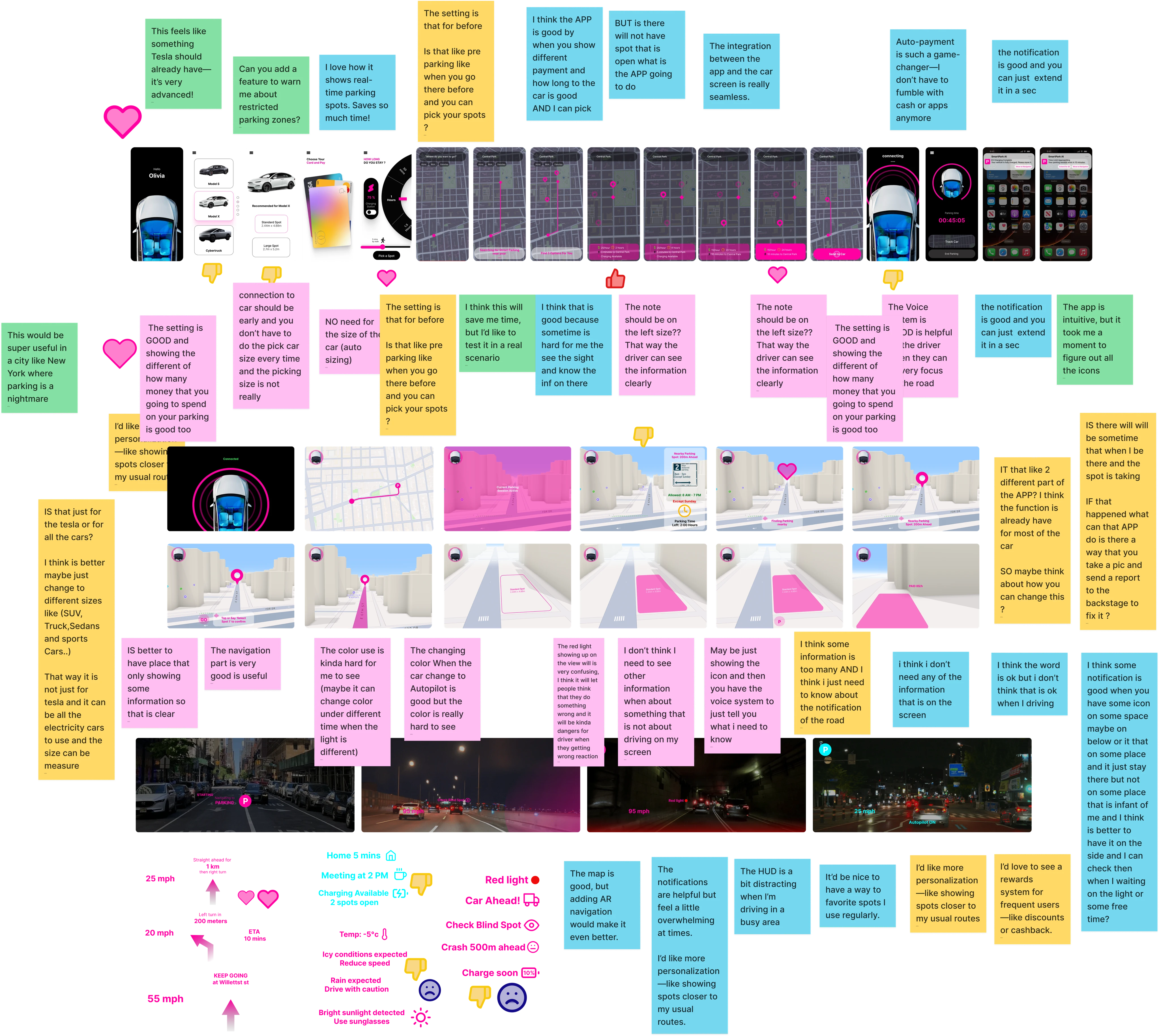
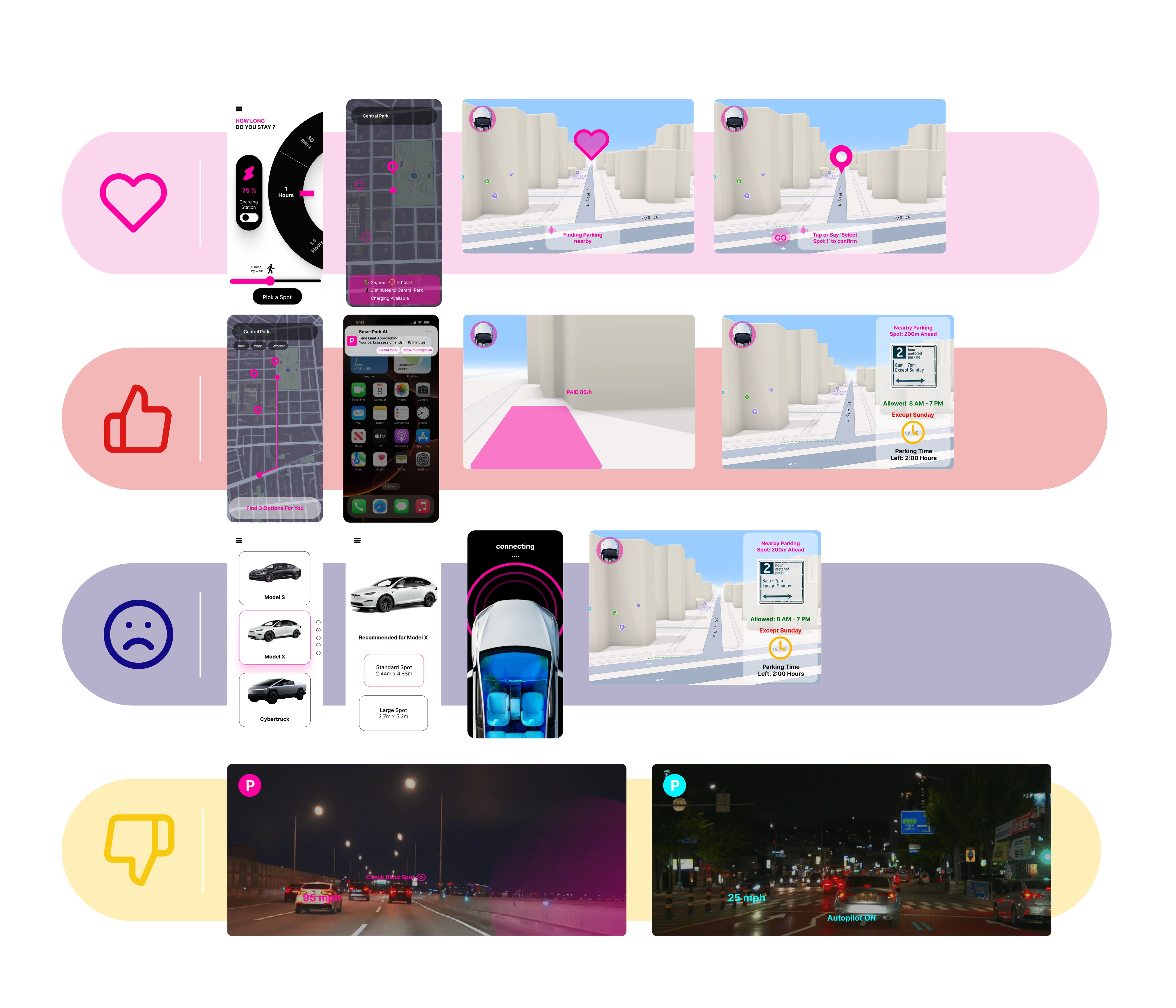
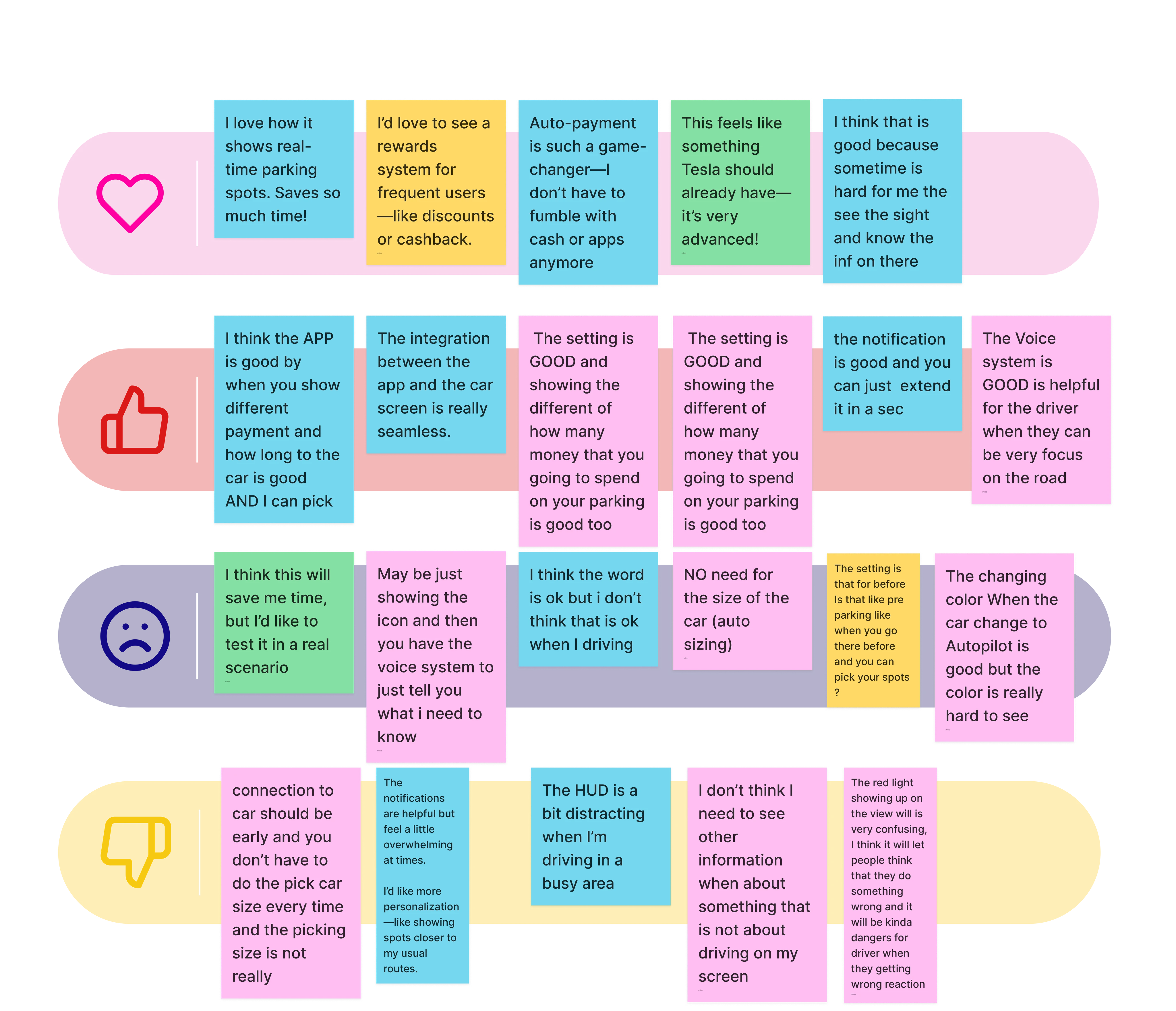

LOVE
LIKE
DISLIKE
HATE
Driven by Feedback, Refined for Simplicity
Feedback revealed users preferred minimal interfaces to reduce distraction while driving. This led to removing the in-car dashboard, shifting the focus to HUD for critical updates and the mobile app for control and customization.
Mobile App
In-Car Infotainment Screen
01
Before the Drive
02
During the Drive
03
Glanceable Information
Windshield HUD
Key Learning
80%
A.What Worked Well (Positive Feedback):
of participants understood the overall concept of the product.
Participants liked the real-time parking suggestions for busy urban areas.
40%
B. Areas for Improvement (Pain Points):
of participants found the dashboard switching (Plan A to Plan B) confusing.
Participants suggested voice commands to reduce distraction.
80%
C. General Usability:
successfully completed tasks using the
product’s features.
0%
C. General Usability:
experienced technical difficulties
or major frustrations.
Key Recommendations
Simplify HUD Design:
Reduce visual clutter and add an option to toggle on/off certain elements.
Add Voice Commands:
Enable users to search and navigate via voice for safer interaction while driving.
Improve Clarity:
Display parking rules (e.g., time limits, restrictions) more prominently.
Personalization Options:
Allow users to customize notifications and save preferred parking spots.
Interactive Onboarding:
Include a short tutorial or walkthrough for first-time users to explain dashboard features.
Framing the NEW Problem
With the rise of autonomous vehicles, the in-car experience needs to be simplified for safety and efficiency. Traditional solutions rely heavily on multiple screens, creating complexity for users.
From Complexity to Efficiency

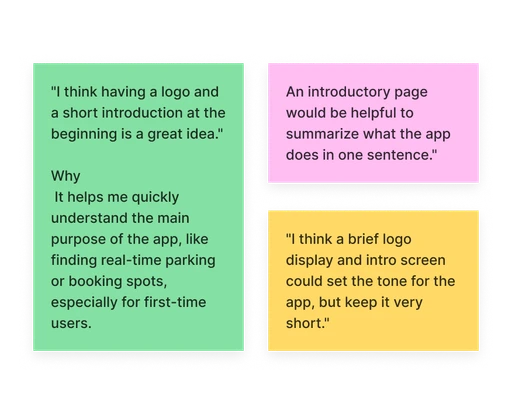
Changes:
Added a logo intro with a clear tagline.
Enhanced visuals with gradients and car imagery.
Streamlined navigation with clear CTAs.
Simplified account creation and login.
Strengthened branding consistency.
Improved Onboarding Experience
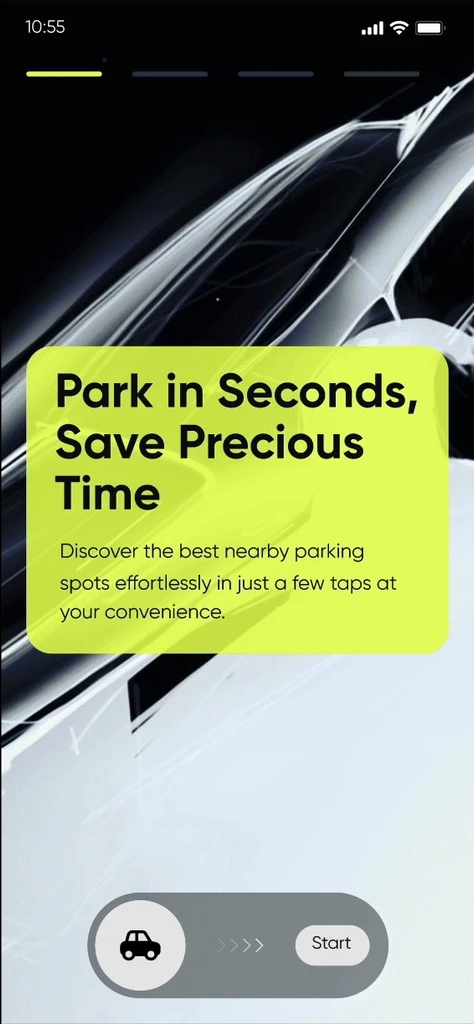
VS
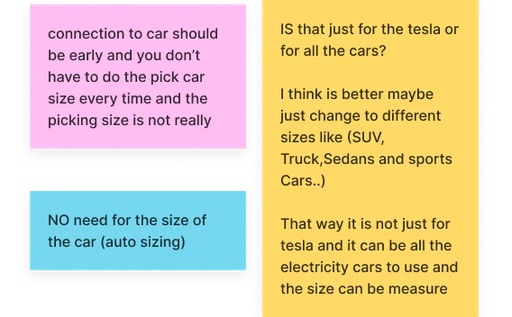
Future Vehicle Selection
Changes :
Replaced real Tesla models with three futuristic, imagined vehicles:
Eon Glide: Elegant and efficient sedan.
Terra Voyager: Rugged SUV for all terrains.
Volt Hauler: Powerful and futuristic electric pickup.
Focused on broader usability by removing car-specific selections and introducing generic future categories.Designed vehicles to represent diverse use cases for a futuristic, electric-first ecosystem.

VS
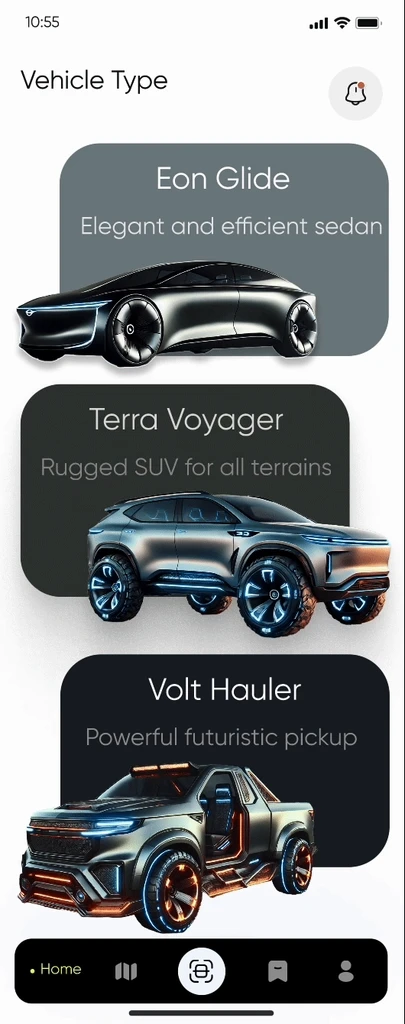
Enhanced Interface
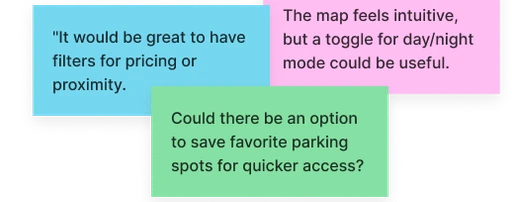

VS
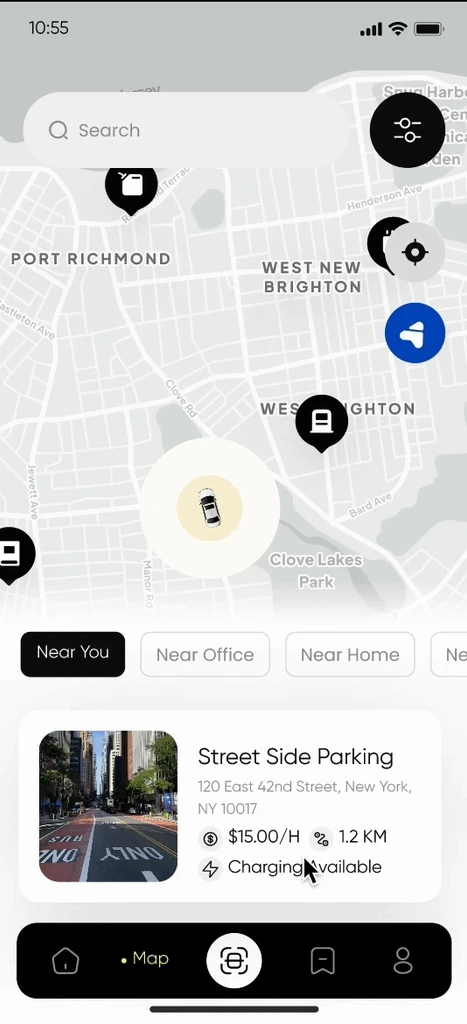
Changes:
Simplified design for a modern look.
Added personalized options (e.g., "Near You").
Included real-time parking visuals.Improved map navigation.
Navigation BAR
Changes:
Placing the navigation bar at the bottom makes it easier for users to operate with one hand, quickly access key features, and enjoy a smoother user experience.


Branding
Stylescapes



Brand visuals
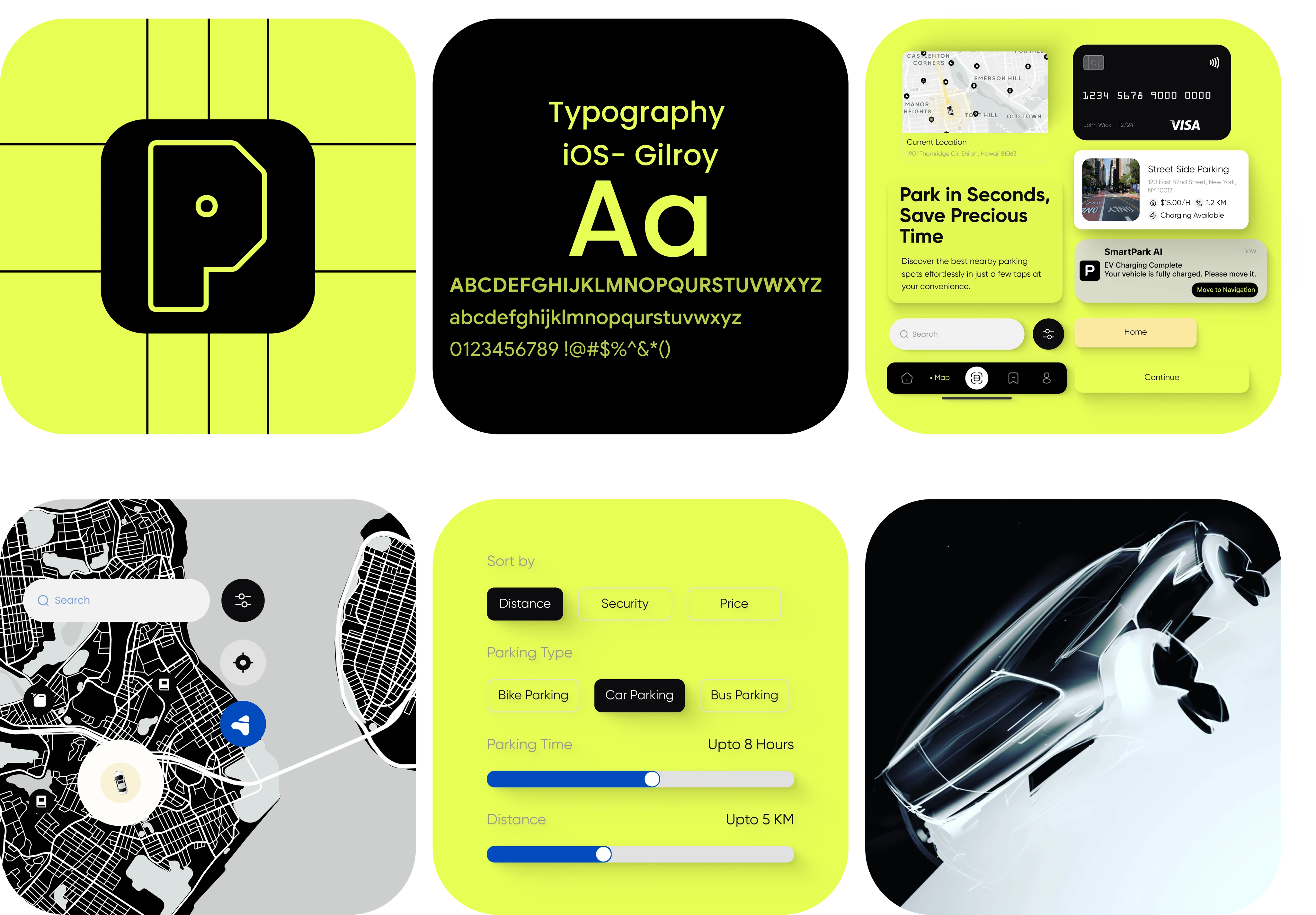
UI design system
